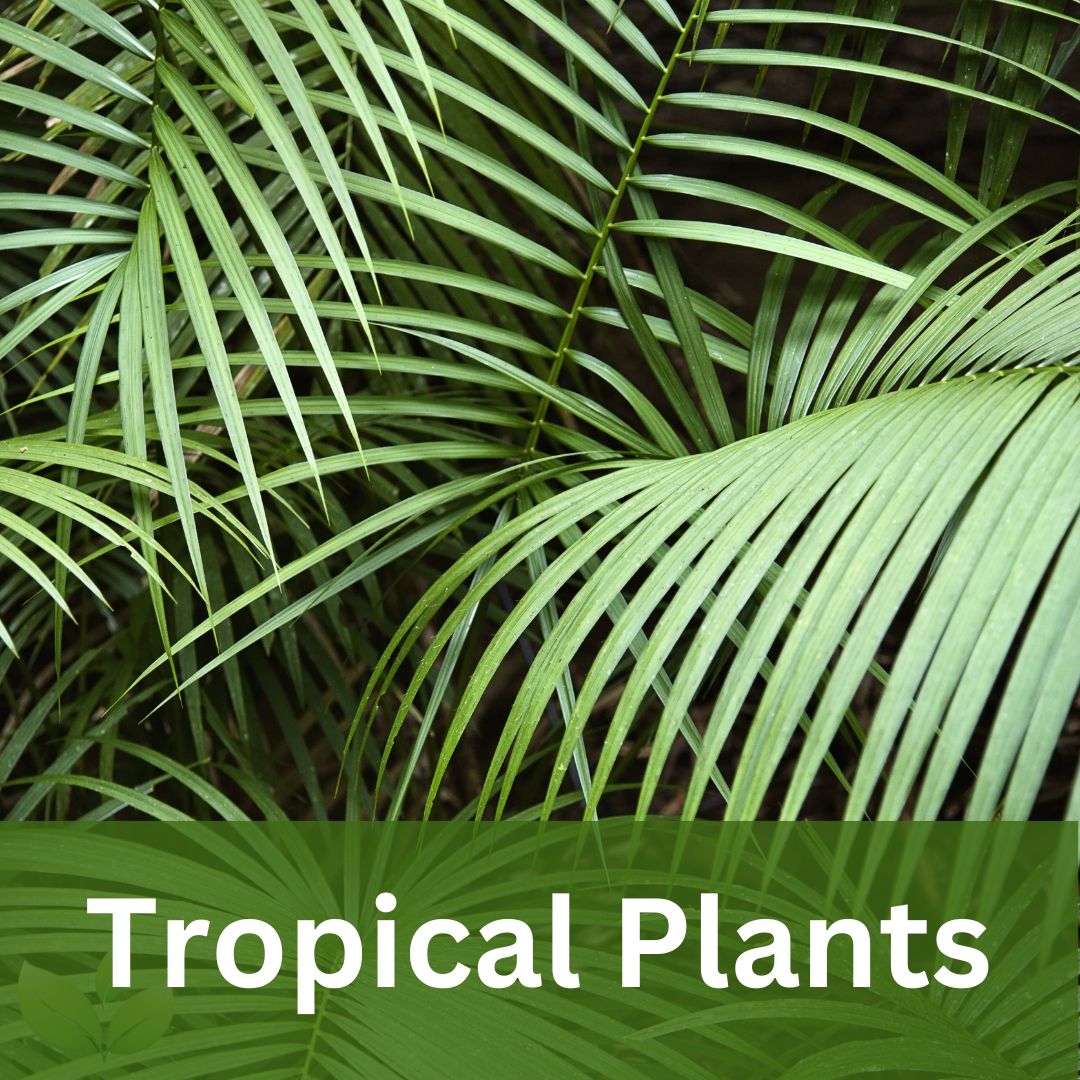
Tropical Plants for Sunshine Coast
Pay less for Retail Quality Plants, See them In-store or Online & have them delivered straight to your door

Come on down and see our plants in-Store or Online 7 Days a week. Pick them up or have them Delivered we have you covered.
these have just arrived in August 25. looking great and budding. see instore or order online and have them delivered
Check out some of the latest pots just arrived into the Garden Centre - get in Quick these won't last
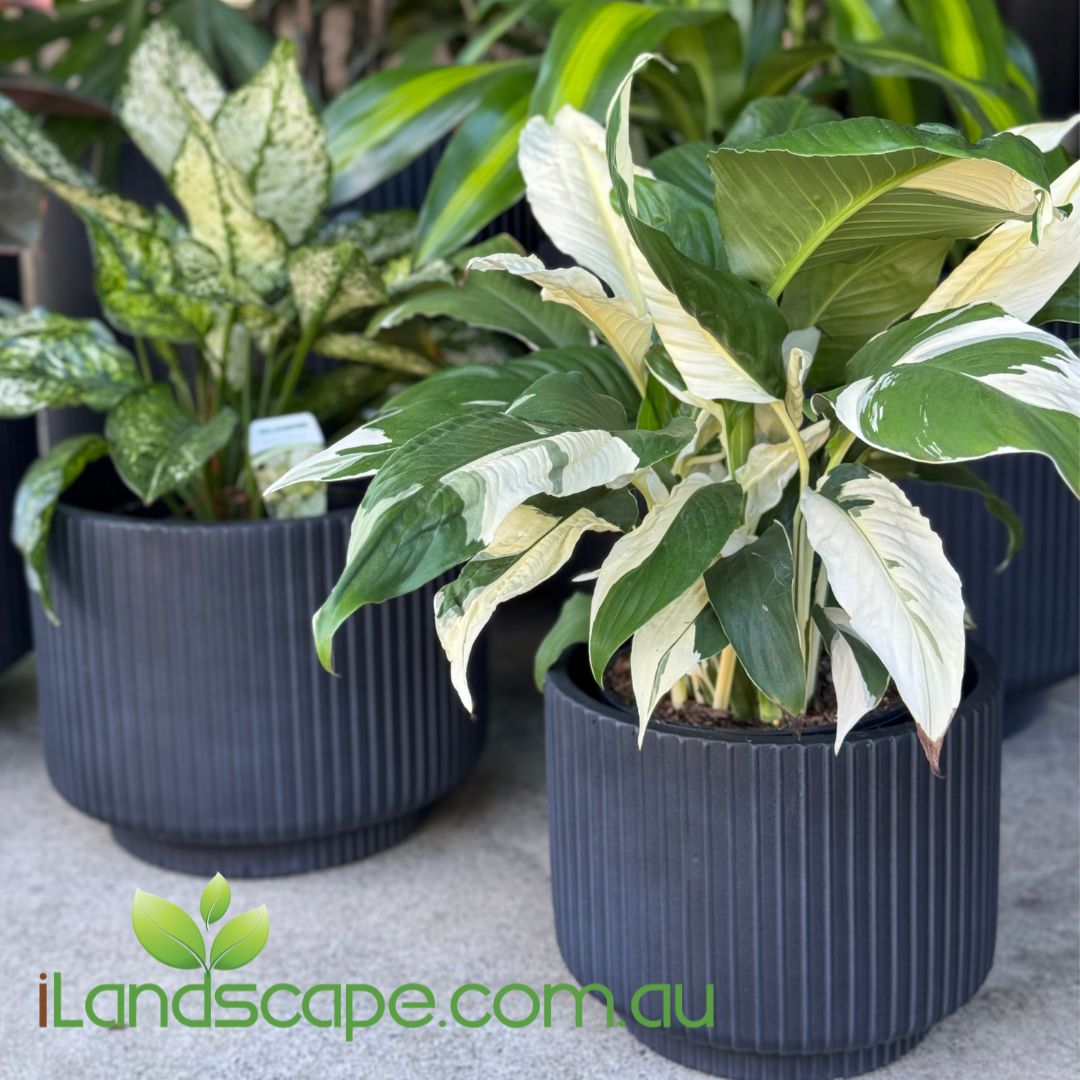
Chord Footed Cylinder Planter Pot
The Chord Footed Cylinder Planter Pot is a sleek, modern choice for showcasing your favourite indoor and outdoor plants. Crafted from high-quality lightweight GFC (Glass Fibre Cement), it offers the strength and durability of traditional stone pots without the heavy weight, making it easy to move and position. Its vertical ribbed texture and subtle footed base add a stylish architectural touch, perfect for contemporary and minimalist spaces. Available in five versatile sizes, this planter is ideal for everything from small feature plants to large statement specimens. Suitable for both residential and commercial settings, it blends effortlessly into a wide range of design styles while giving your plants a beautiful, elevated presentation. Features: Made from durable, lightweight GFC (Glass Fibre Cement) Vertical ribbed finish with a modern footed base Weather-resistant and suitable for indoor or outdoor use Available in 5 practical sizes for a variety of plants Easy to move and position compared to traditional stone pots Uses:Perfect for feature plants, grouped displays, or as a stylish standalone statement piece in gardens, patios, balconies, or interior spaces. Small - 24cm W x 19 H Medium - 30cm W x 24 H Large - 37cm W x 30 H X Large - 44cm W x 36 H XX Large - 54cm W x 43cm H Colours - Grey/Black or White Terrazzo use our chat button to check on availability
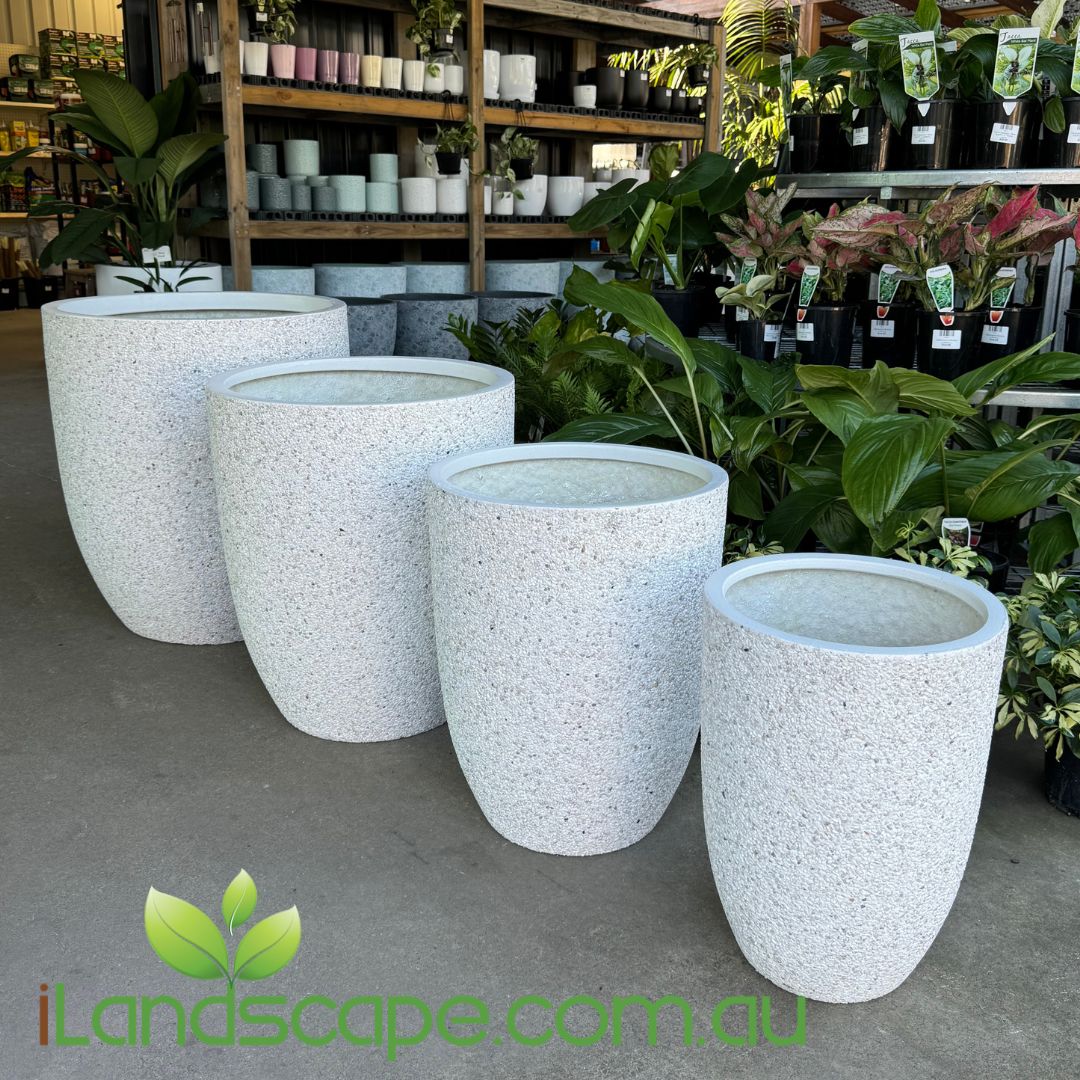
Chamber U Pots - Pebble finish
Chamber U Planter Pots in Pebble finish are the same sizes and shape as the existing Chamber u however they are finished using a Pebble crete finish. They look amazing and their finish is first class. A must to come and view in store if your on the Sunshine Coast Available individually in 4 sizes Small - 350 W x 490 H Medium - 450 W x 560 H Large - 550 W x 640 H X Large - 640 W x 720 H Available in 1 Colour - White Pebble
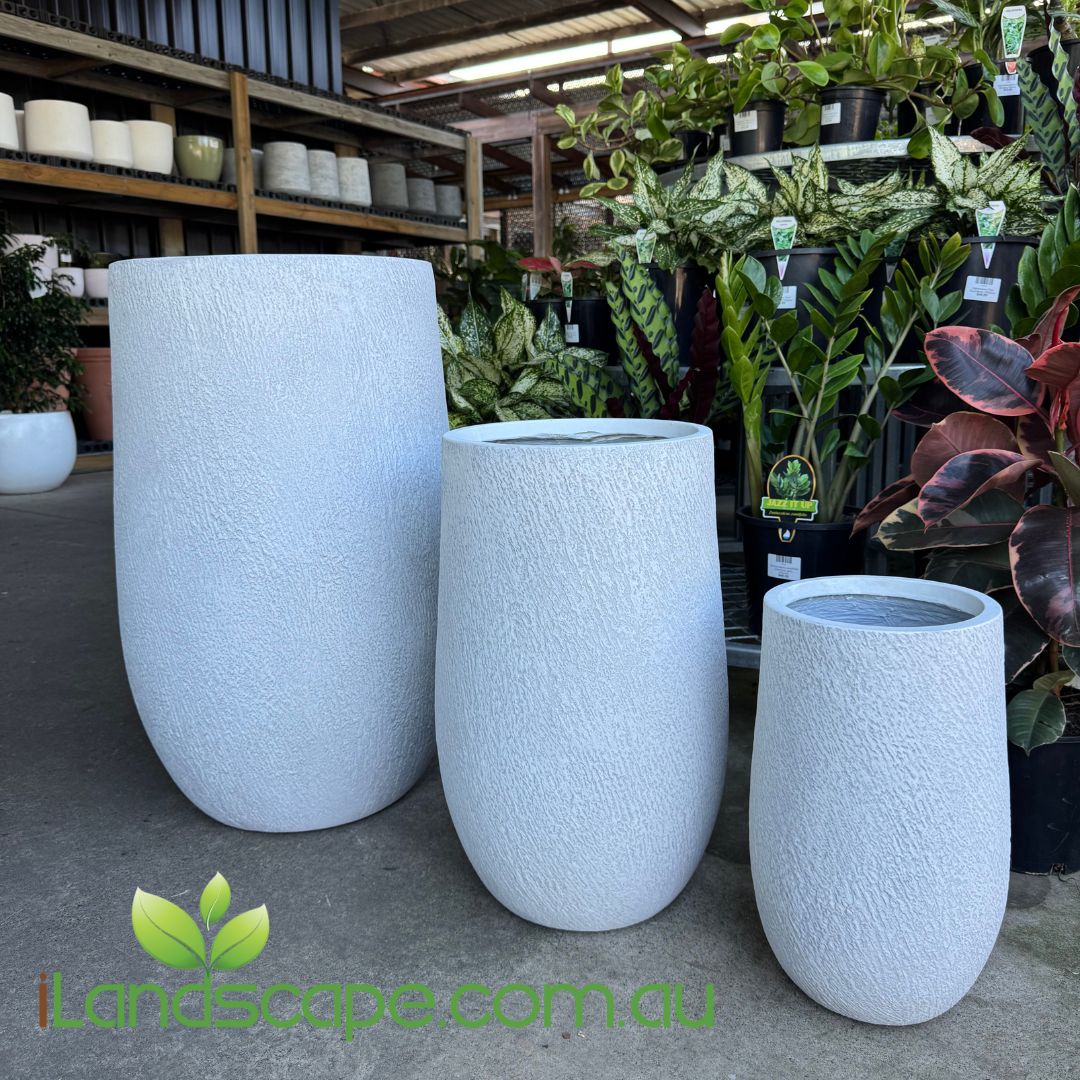
Slate U Planter Pot — 3 Sizes | 3 Colours
Description The Slate U Planter Pot combines modern style with practical elegance, making it the perfect choice for both indoor and outdoor spaces. Featuring a sleek curved U-shape with a lightly textured stone finish, this planter brings a contemporary and minimalist touch to any garden, patio, balcony, or interior setting while complementing a wide variety of plants. Crafted from lightweight, durable materials, it’s easy to move, weather-resistant, and designed to withstand Australian conditions. The neutral tones and timeless shape make it ideal for pairing with statement plants, lush greenery, or vibrant floral arrangements, making it perfect for home gardens, courtyards, and modern landscaped spaces. Features Modern curved U-shape design with textured finish Available in three colours: black, grey, and white Lightweight, durable, and weather-resistant construction Suitable for both indoor and outdoor use Perfect for feature plants, grouped displays, or styling accents Uses Ideal for modern gardens, patios, courtyards, and balconies Perfect for feature plants such as palms, fiddle leaf figs, ferns, or flowering shrubs Complements a wide range of pots, planters, and garden décor Suitable for residential and commercial landscaping projects Available Sizes & Colours Small - 25cm x 40cm H Medium - 35cm x 55 cm H Large - 48cm x 75cm H Colours Available: Black, Grey, White
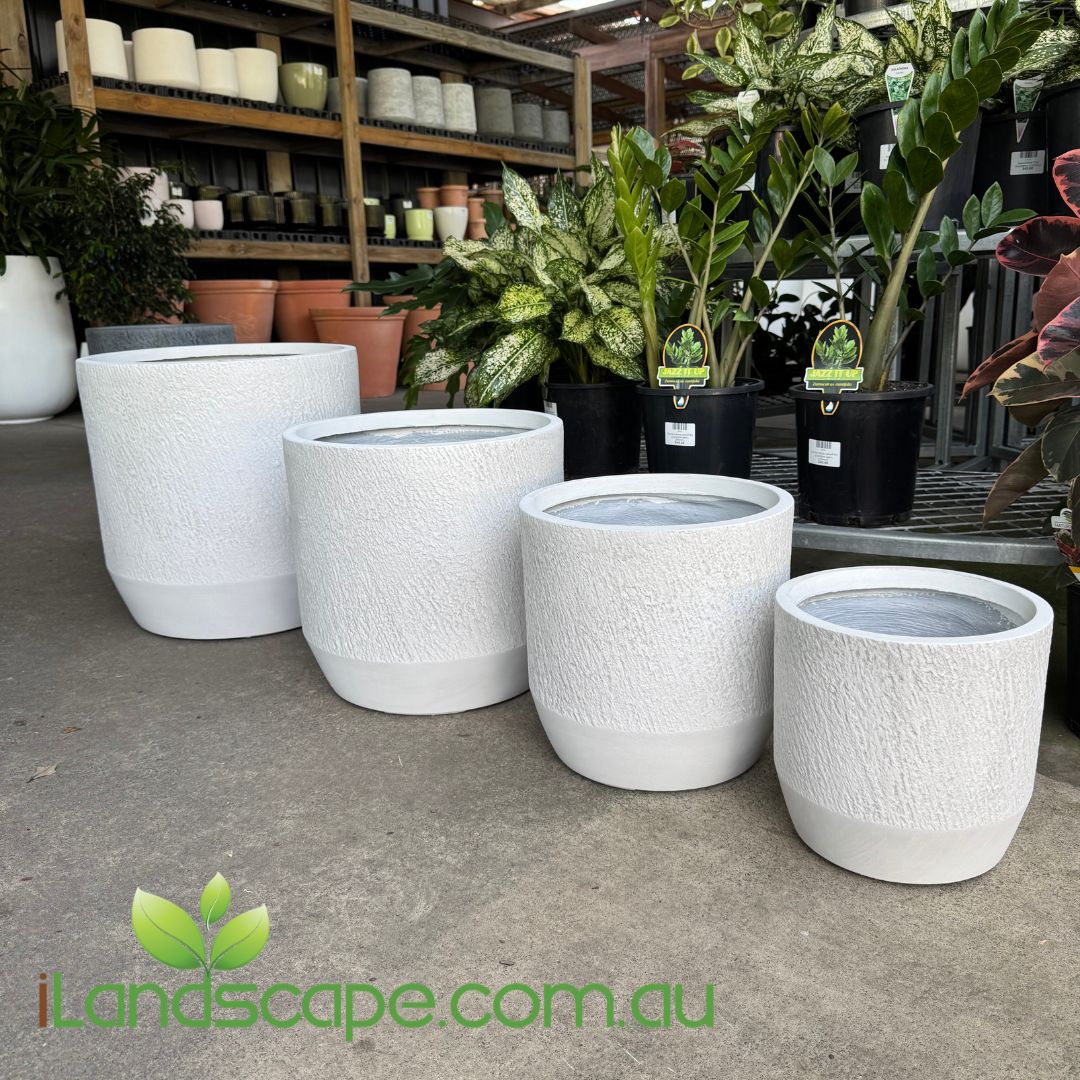
Slate Cylinder Planter Pot — 4 Sizes | 3 Colours
The Slate Cylinder Planter Pot offers a stylish and versatile design that suits both indoor and outdoor spaces, making it perfect for modern homes and landscaped gardens. Featuring a smooth cylindrical shape with a subtle textured finish, these planters bring a contemporary and timeless look that complements a wide range of plants and décor styles. Crafted from lightweight, durable, and weather-resistant materials, the Slate Cylinder Planter Pot is designed to withstand Australian conditions while being easy to move and position as needed. Available in four practical sizes and three modern colours black, grey, and white this collection is perfect for showcasing statement plants, feature shrubs, or lush greenery in home gardens, patios, courtyards, and interior settings. Whether used as standalone pieces or styled together as a set, the Slate Cylinder Planter Pot creates an elegant, cohesive look that enhances any space with a touch of modern sophistication. Features Modern cylindrical design with a subtle textured finish Available in three colours: black, grey, and white Lightweight, durable, and weather-resistant construction Suitable for both indoor and outdoor use Perfect for feature plants, grouped displays, or decorative styling Uses Ideal for modern gardens, patios, balconies, and courtyards Perfect for feature plants such as palms, fiddle leaf figs, ferns, or flowering shrubs Complements a wide range of pots, planters, and outdoor décor Suitable for residential and commercial landscaping projects Available Sizes & Colours Small: 24cm W x 24cm H Medium: 30cm W x 30cm H Large: 37cm W x 37cm H Extra Large: 44cm W x 44cm H Colours Available: Black, Grey, White
Check out the range of Ancient Pots we have. These planter pots are suitable for Indoor staging, Outdoor planting as well as converting into Water features
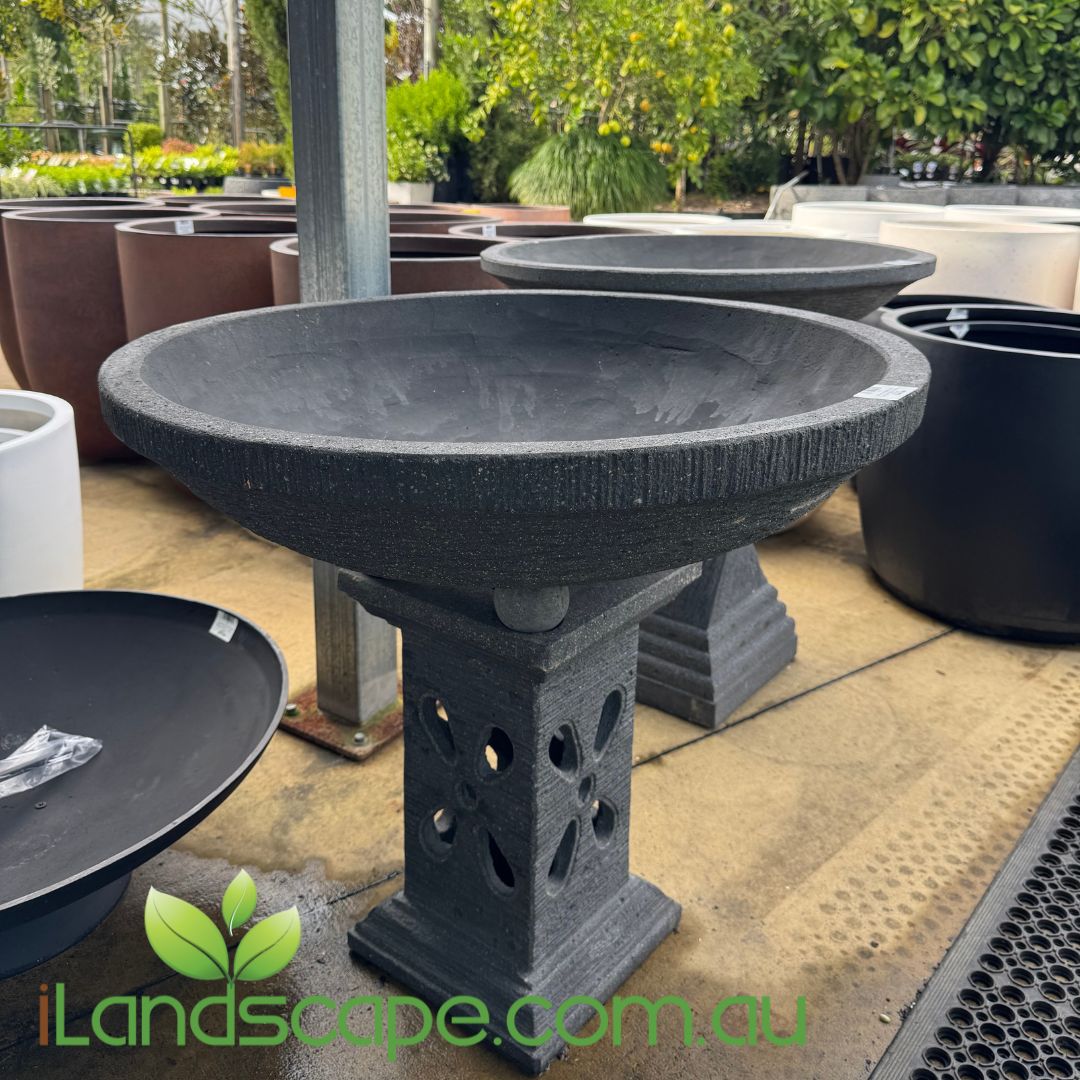
Bowl on Balls w/ X Pedestal
Check out these amazing Bowl on Pedestal option for your next project, use it as a bird bath or plant it out it has options. This colour only and is 80cm Wide x 67cm High Transform your outdoor space with our statement garden features, available through iLandscape on the Sunshine Coast
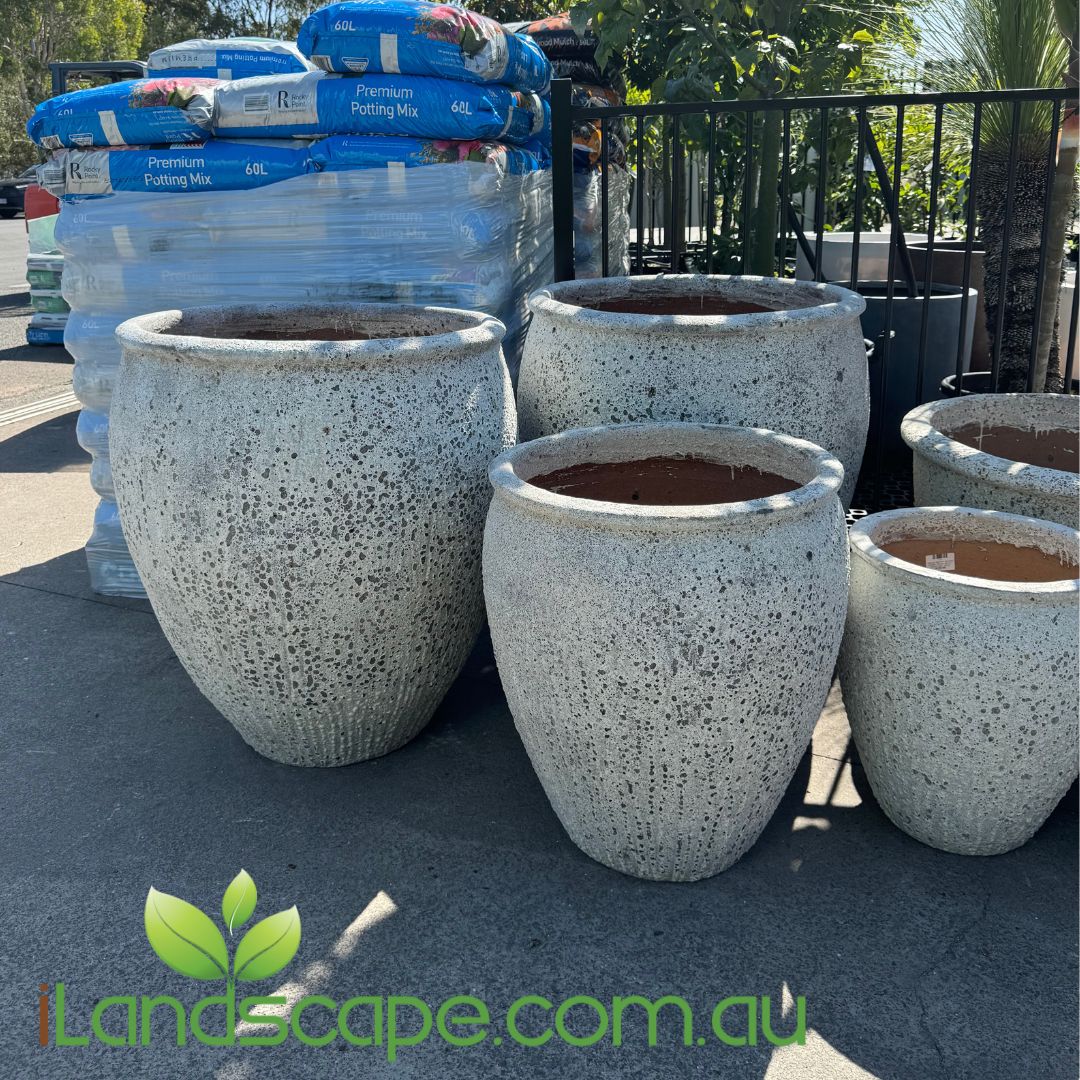
Ancient Athens Tall Pot - Also known as Driftsone Moku Planter
Athen Tall Planter Pot is suitable for both indoor and outdoor use. Made from teracotta and available in the Ancient white finish Sizes Available Small - 45cm x 52cm High Medium - 57cm x 66xm High Large - 78cm x 84cm High
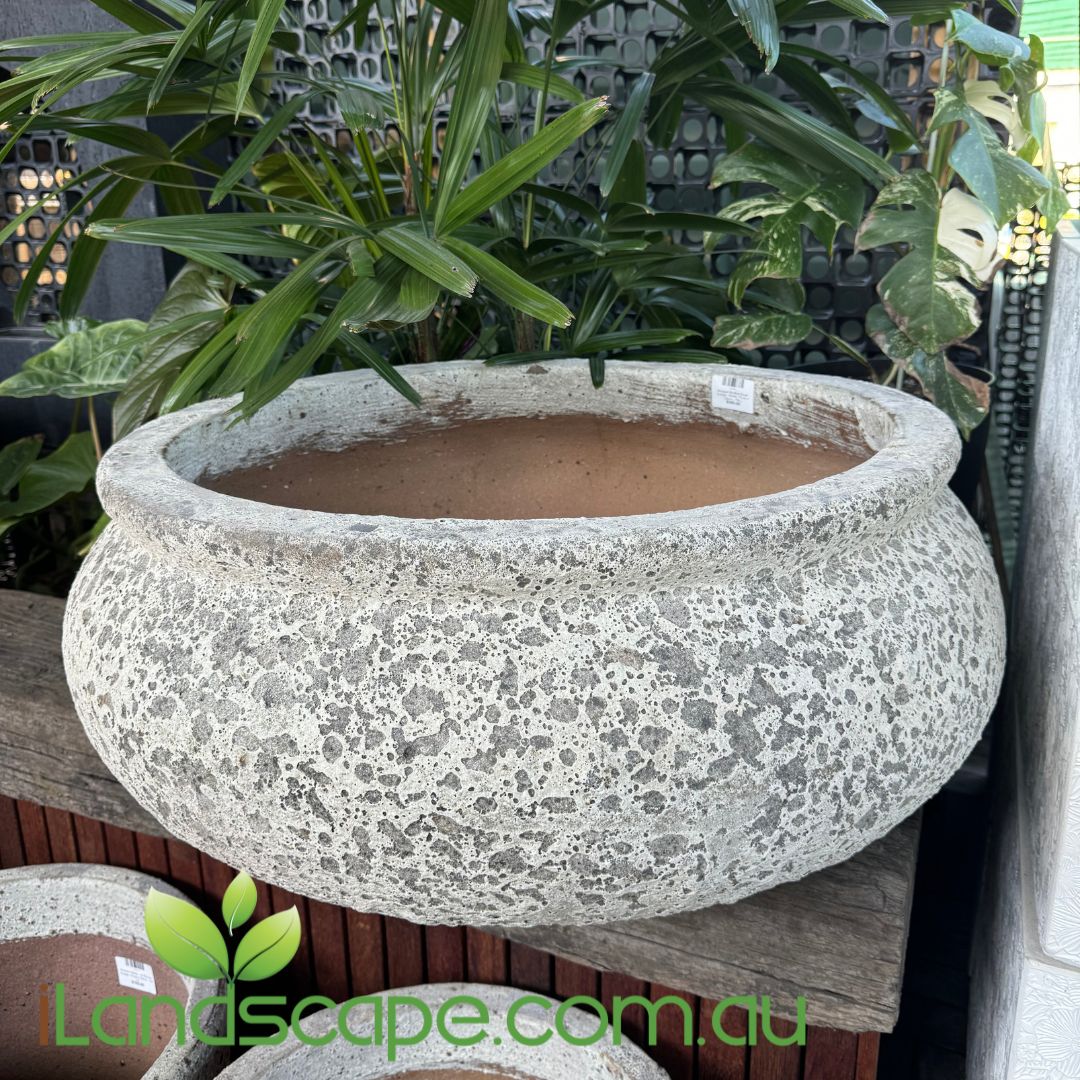
Ancient Shallow Bowl
Make a statement with these Ancient Shallow Bowls. Suitable for both indoor our outdoor planting pot or Water feature Available in 2 x sizes Small - 57cm x 25cm - 30L Large - 77cm x 32cm - 70L Colour available is Ancient White
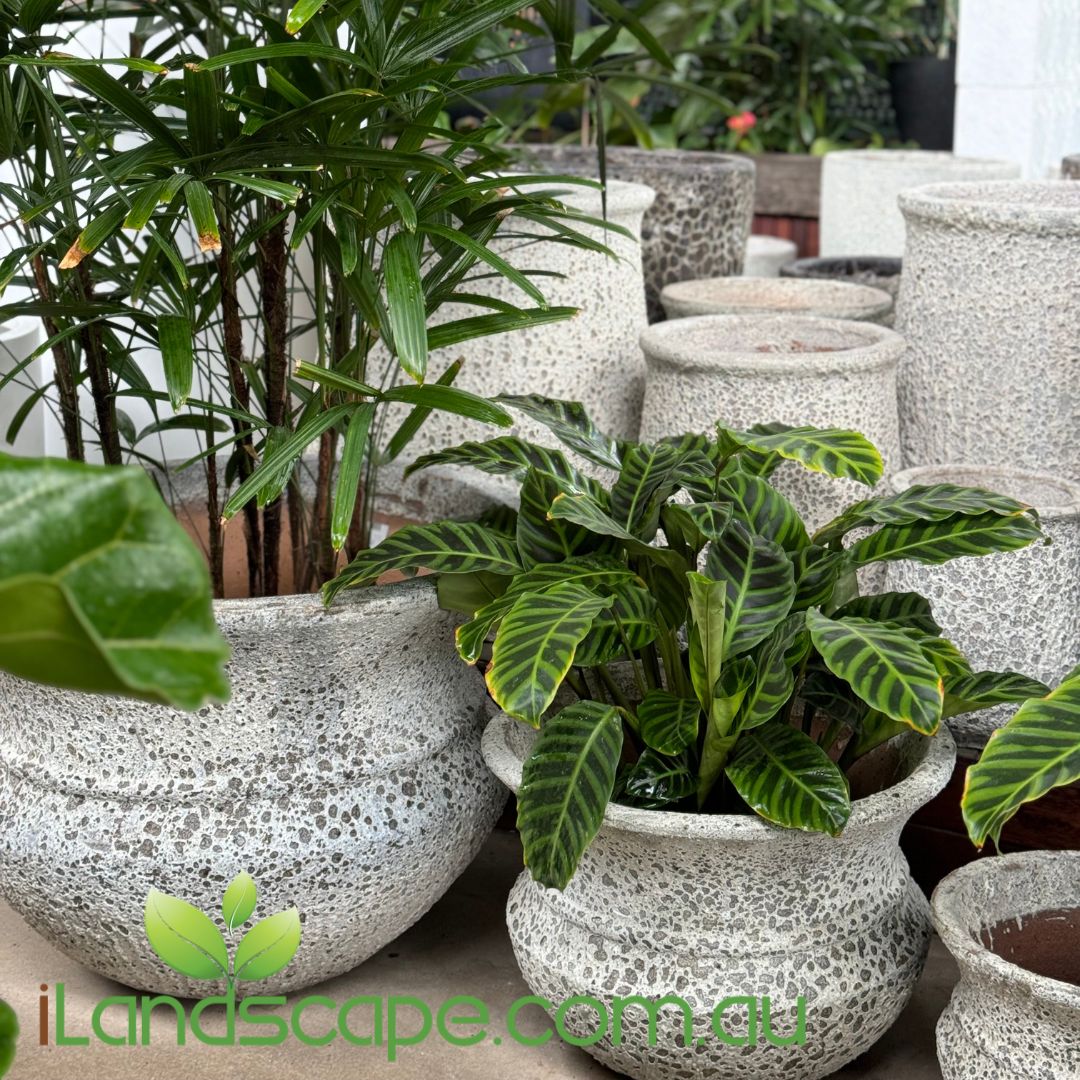
Ancient Lucinda Pot
Great Quality Pot that is suitable for both indoor & Outdoor planting. available in 3 x Sizes Small - 36cm x 24cm - 15L Medium - 50cm x 33cm - 40L Large - 74cm x 51cm - 140L Colour Available - Antique White
So many Styles, Sizes and Colours to choose from. We update our pots regularly and have new Pots coming into store every week.
If your looking for a Pot its definitely worth the visit
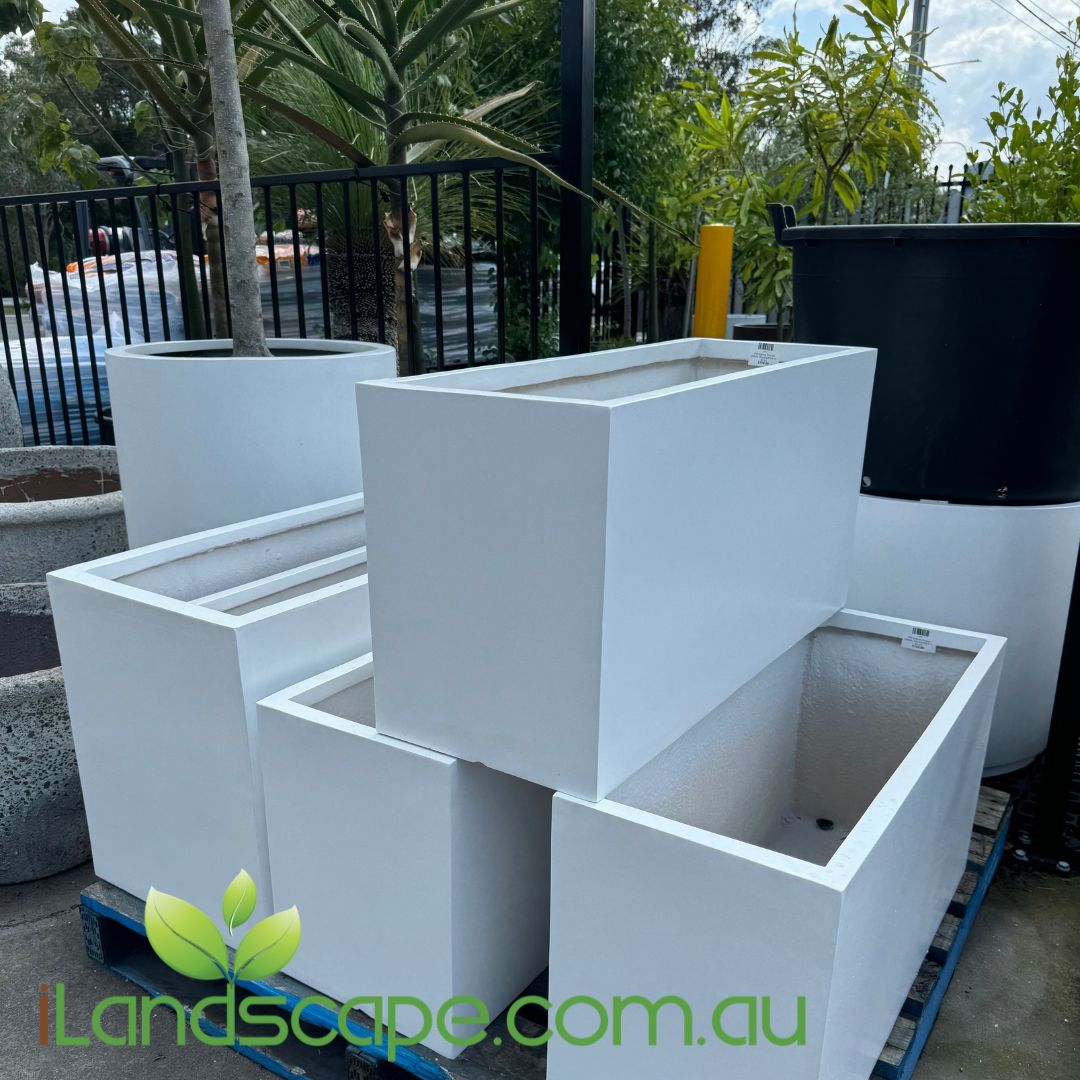
Fibrestone Planter Trough - Also known as Shoreline trough
beautiful planter trough available in 2 x Sizes and 3 x Colours made from light weight Fibreglass. can be used for both indoor and outdoor planting Colours White Black Grey Sizes Small - 80cm x 30cm W x 40cm High Large - 100cm x 40cm W x 50cm High
Sale
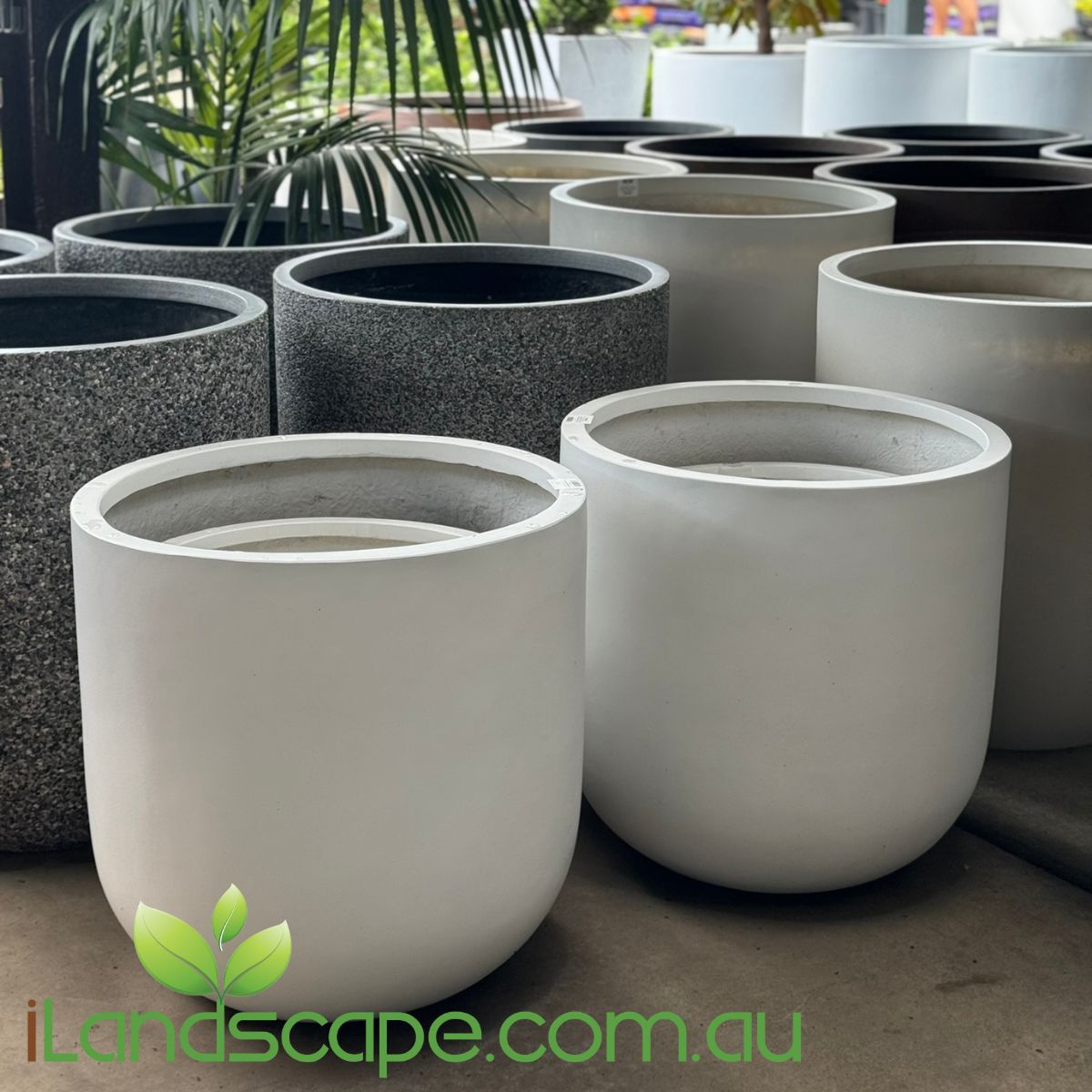
Plaza U Planter
Fibrestone Horseshoe Pot are a Light Weight Quality Pot available in 5 x Sizes and 2 x Colours Available individually in 5 sizes Small - 50cm H x 50 W Medium - 60cm H x 60 W Large - 70cm H x 70 W X Large - 80cm H x 80 W XX Large - 90cm H x 90 W Available in 2 Colours Black White please note that all images are only indicative colours and should be inspected in person at iLandscape prior to purchasing
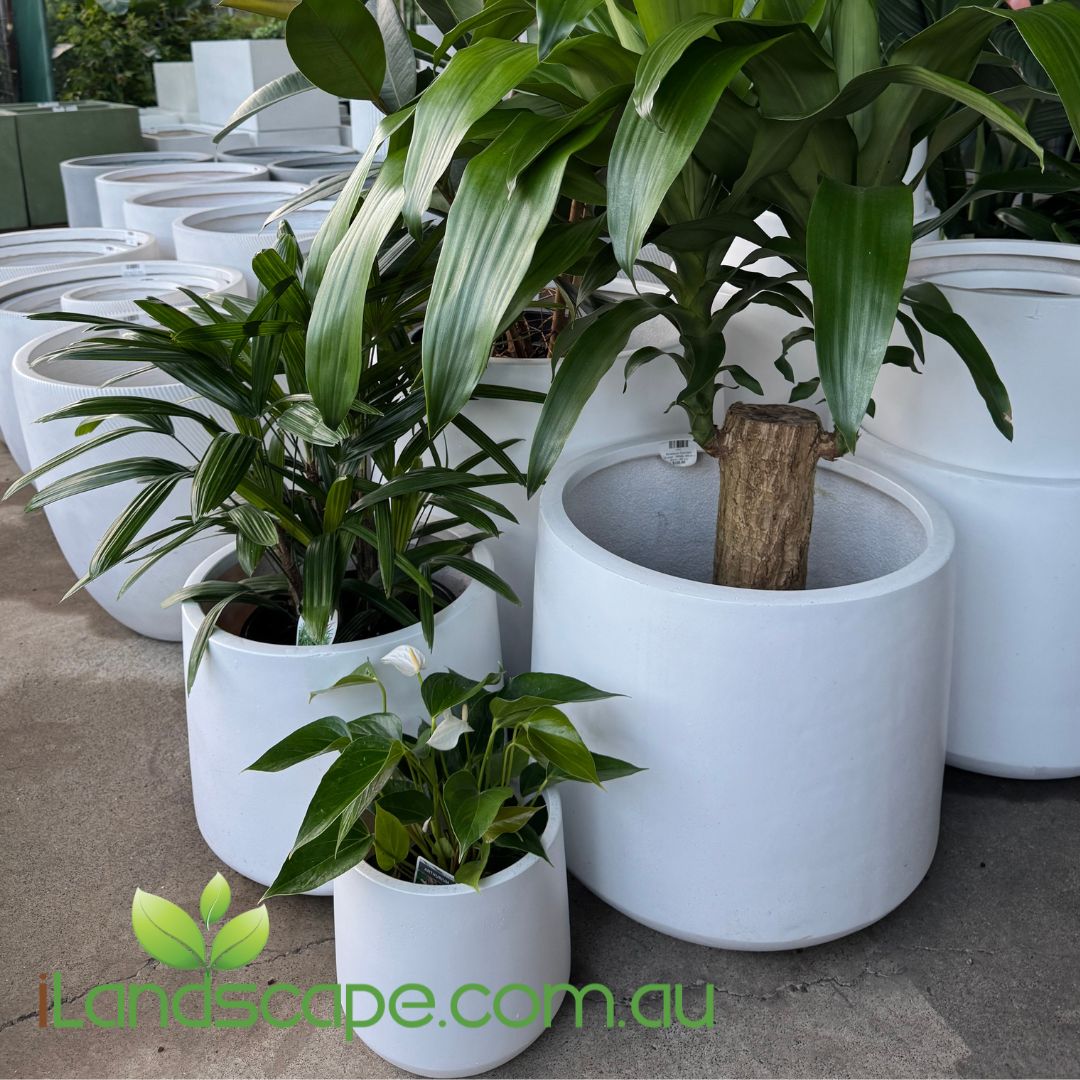
Modstone Cylinder Planter Pot
The Modstone Cylinder Planter Pot offers a clean, contemporary look that complements both indoor and outdoor plant styling. Featuring a smooth cylindrical design with a slightly tapered base, these planters bring a modern edge while allowing your plants to take centre stage. Crafted from high-quality Modstone, a durable yet lightweight composite, they deliver the appearance of solid stone without the heavy weight, making them easy to move and arrange. Available in a range of sizes, the Modstone Cylinder Planter Pot is perfect for everything from small indoor plants to large statement trees. Its versatile design suits modern homes, offices, patios, and commercial spaces. Features: Sleek cylindrical design with smooth, modern finish Made from durable, lightweight Modstone composite Weather-resistant for indoor or outdoor use Available in multiple sizes to suit various plant types Easy to move compared to traditional stone pots Uses:Perfect for entrances, patios, courtyards, or as part of a coordinated plant display. Ideal for residential gardens and commercial spaces seeking a stylish, low-maintenance planter solution. Available in 5 x Sizes Small - 27cm x 23cm - 10 Lt Medium - 32cm x 28cm - 20 Lt Large - 40cm x 34cm - 35 Lt X Large - 48cm x 40cm - 60 Lt XX Large - 57cm x 48cm - 100 Lt Available in Colours Rust & White
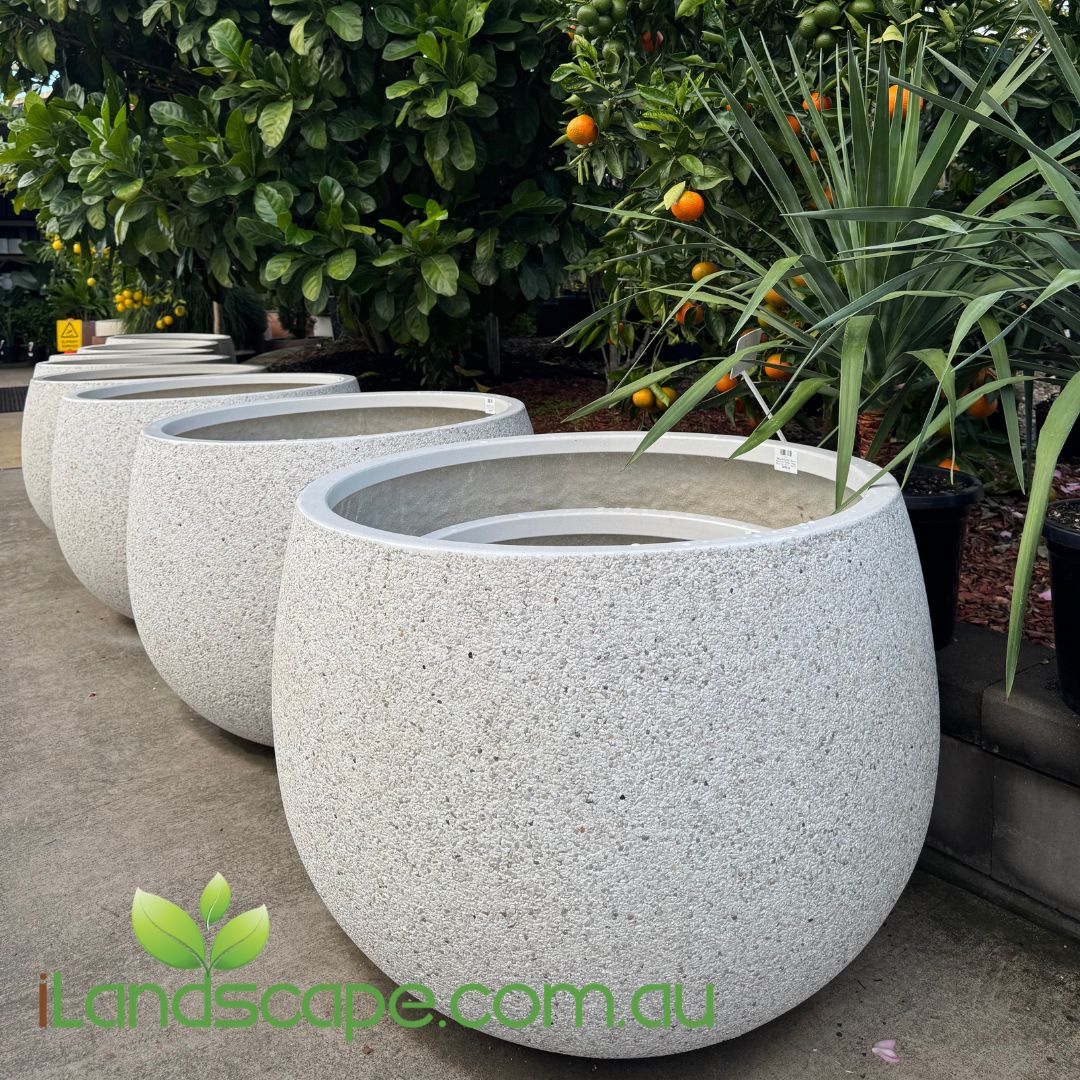
Mega Belly Pot - Pebble Finish
The Mega Belly Pot – Pebble Finish is a bold, contemporary planter designed to make a statement in any garden or landscape. With its generous rounded “belly” shape and textured pebble exterior, this pot brings both elegance and a natural feel to your plant displays. Crafted from high-quality materials for strength and durability, it’s available in two timeless colours — White Pebble and Grey Pebble — to suit a range of styles. Its wide planting area makes it perfect for showcasing large feature plants, trees, or dramatic foliage arrangements. Despite its substantial size, the lightweight construction allows for easier positioning compared to traditional stone pots. Features: Modern rounded “belly” design with a textured pebble finish Available in White Pebble and Grey Pebble colours Lightweight yet strong construction for easy placement Weather-resistant and suitable for indoor or outdoor use Ideal for large plants, small trees, or statement arrangements Uses:Perfect for entryways, patios, courtyards, or as a focal point in the garden. The Mega Belly Pot is also an excellent choice for commercial spaces looking to add greenery with style. Available individually in 6 sizes Extra Small - 27cm W x 20 H Small - 35 W x 27 H Medium - 45 W x 35 H Large - 57 W x 42 H X Large - 72 W x 53 H XX Large - 90 W x 67 H Available in 2 Colours - Dark Grey Pebble - White Pebble
The Fibrestone range of Pots are definitely Quality. Available in many styles and 3 x Colours - White, Black and Industrial Grey
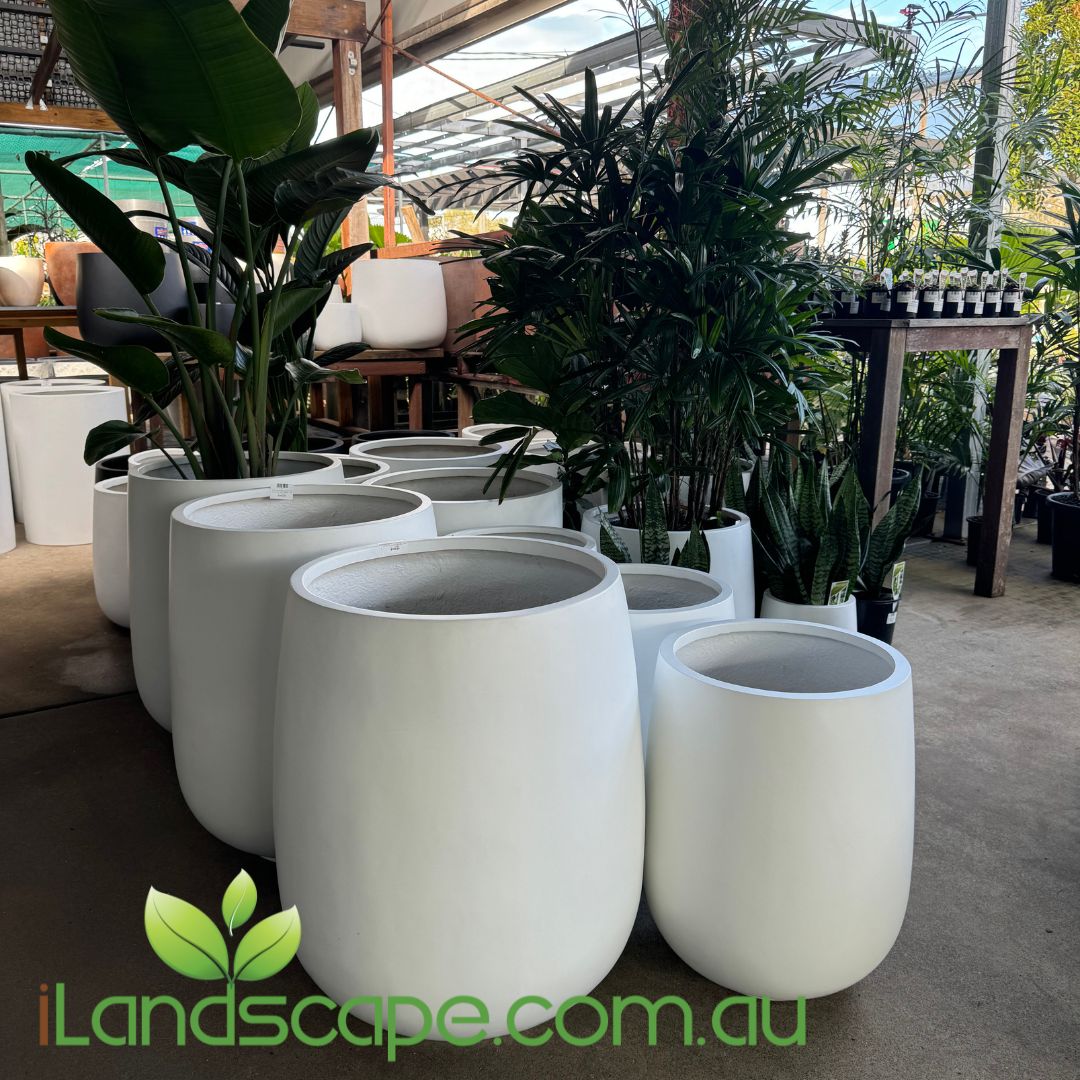
Horseshoe Planter Pot - Also known as Hamptons Pot
Fibrestone Horseshoe Planter Pots are a Light Weight Quality Pot perfect for indoor plants use and outdoor planting. these fantastic planter pots are available in 2 x Sizes and 3 x Colours in our Sunshine Coast Nursery & Garden centre Available individually in 2 sizes Small - 56cm H x 45 W Large - 72cm H x 55 W Available in 3 Colours Black White Grey please note that all images are only indicative colours and should be inspected in person at iLandscape prior to purchasing
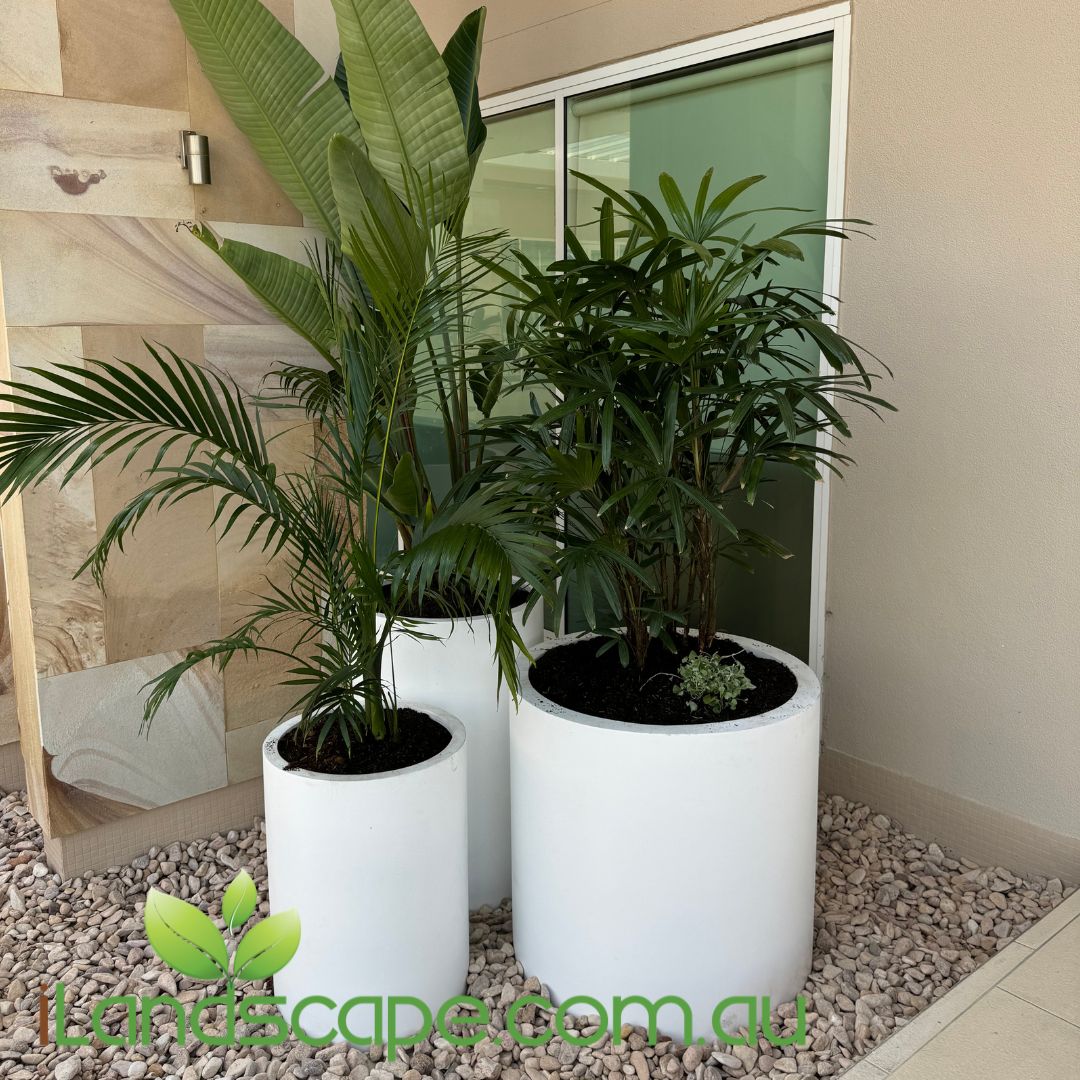
Tall Cylinder Planter Pot
Tall Cylinder Pot are perfect for both indoor plants and outdoor planting. you can plant directly into the pot with outdoor plants or use them as a cover planter pot for your indoor plant collection. these pots are a Light Weight Quality Pot available in 3 x Sizes and 3 x Colours Available individually in 3 sizes Small - 60cm H x 40 W Medium - 70cm H x 50 W Large - 90cm H x 60 W Available in 3 Colours Black White Grey please note that all images are only indicative colours and should be inspected in person at iLandscape prior to purchasing
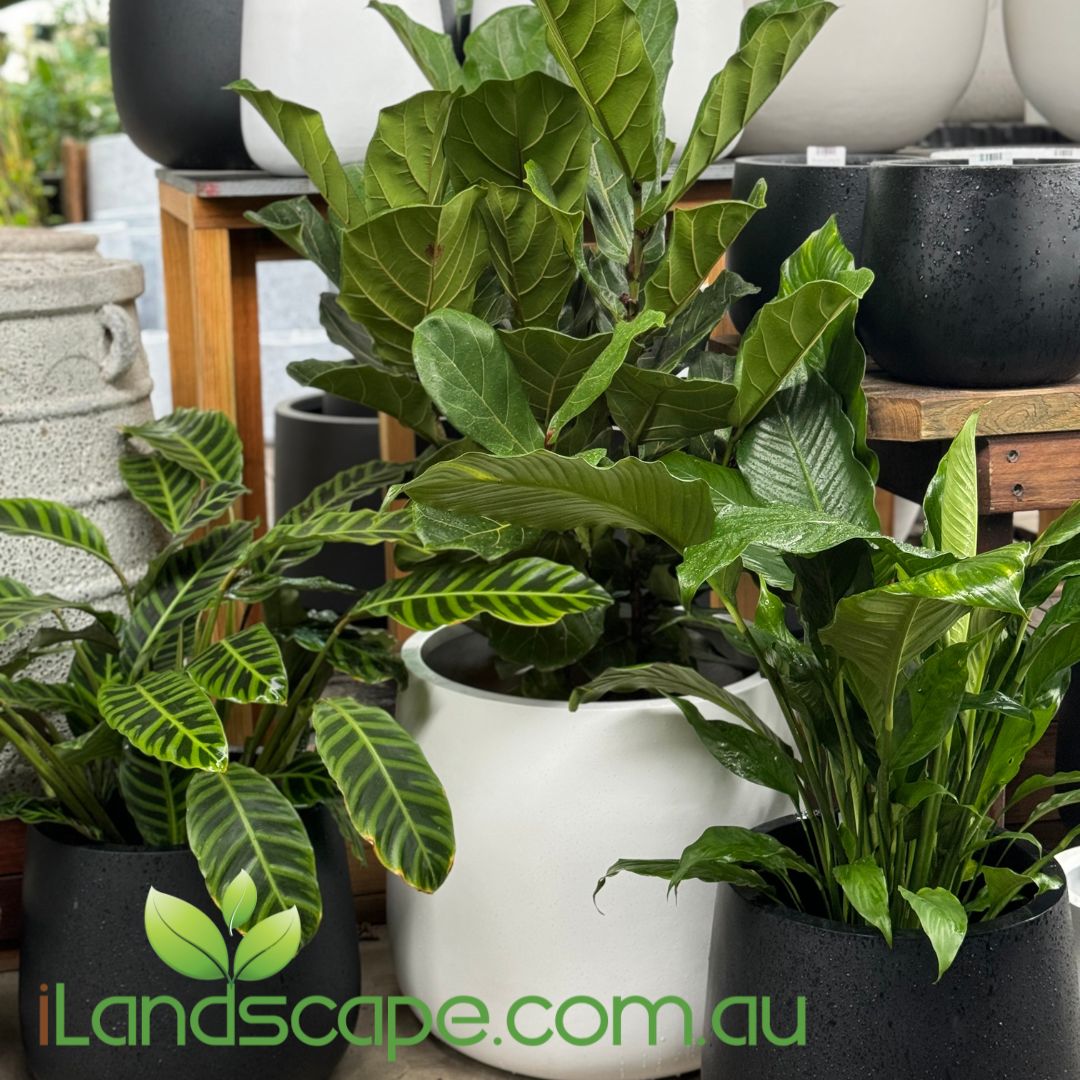
Duffel Planter Pot - Also known as Seabreeze Pot
Fibrestone Duffel Planter Pots are a Light Weight Quality Pot suitable for both Outdoor Planting and Indoor Planter pots. we have them available in 3 x Sizes and 2 x Colours Available individually in 3 sizes Small - 26cm H x 29 W Medium - 36cm H x 41 W Large - 49cm H x55 W Available in 3 Colours Black White Grey please note that all images are only indicative colours and should be inspected in person at iLandscape prior to purchasing
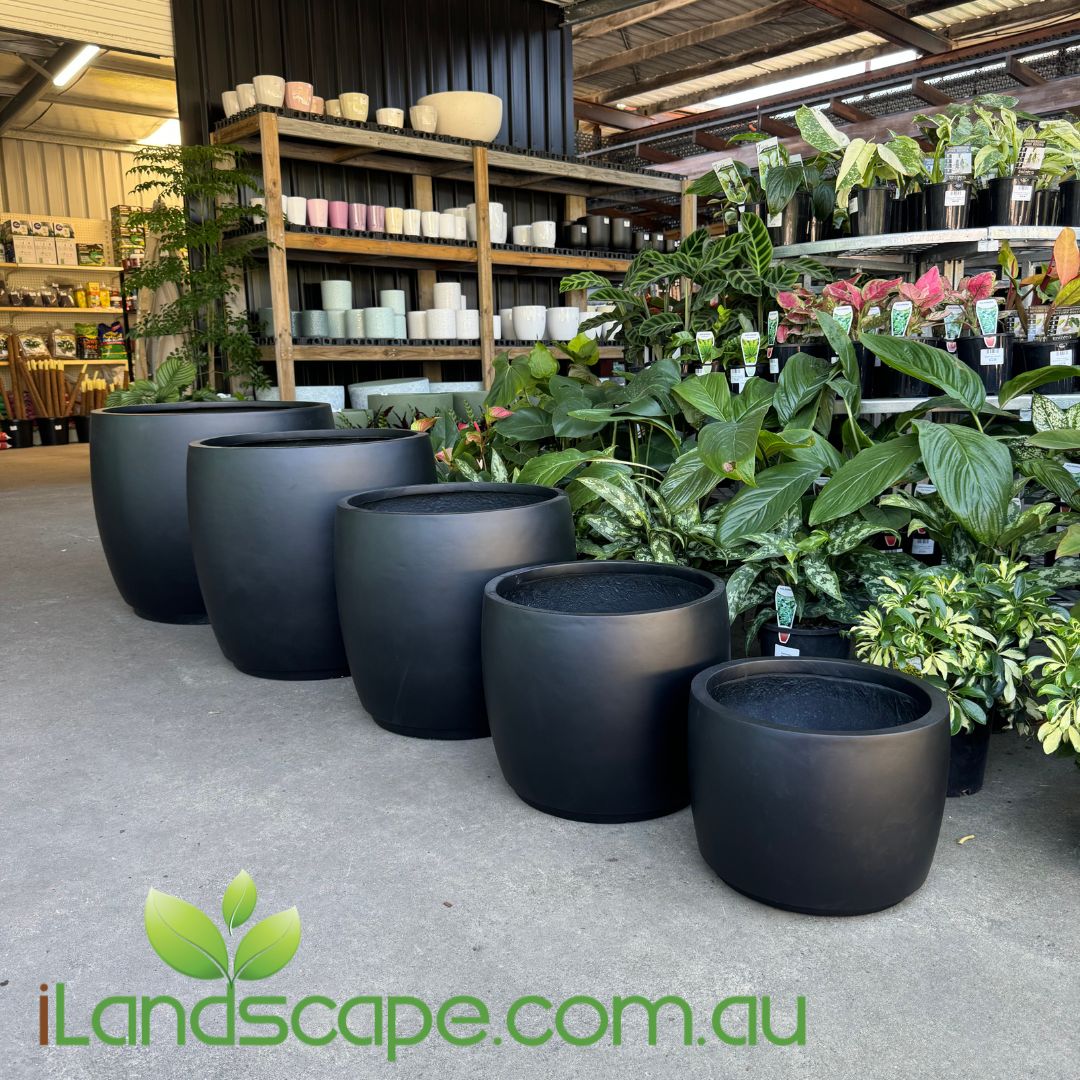
Cask Planter Pot
Beautiful new Planter Pot style available in our Sunshine Coast Nursery and is suitable for both indoor and outdoor planting use. Available in 3 x Colours and 5 x Sizes Colours White Black Grey Sizes Small - 35cm x 25cm Medium - 42cm x 35cm Large - 50cm x 45cm X Large - 60cm x 55cm XX Large - 70cm x 60cm
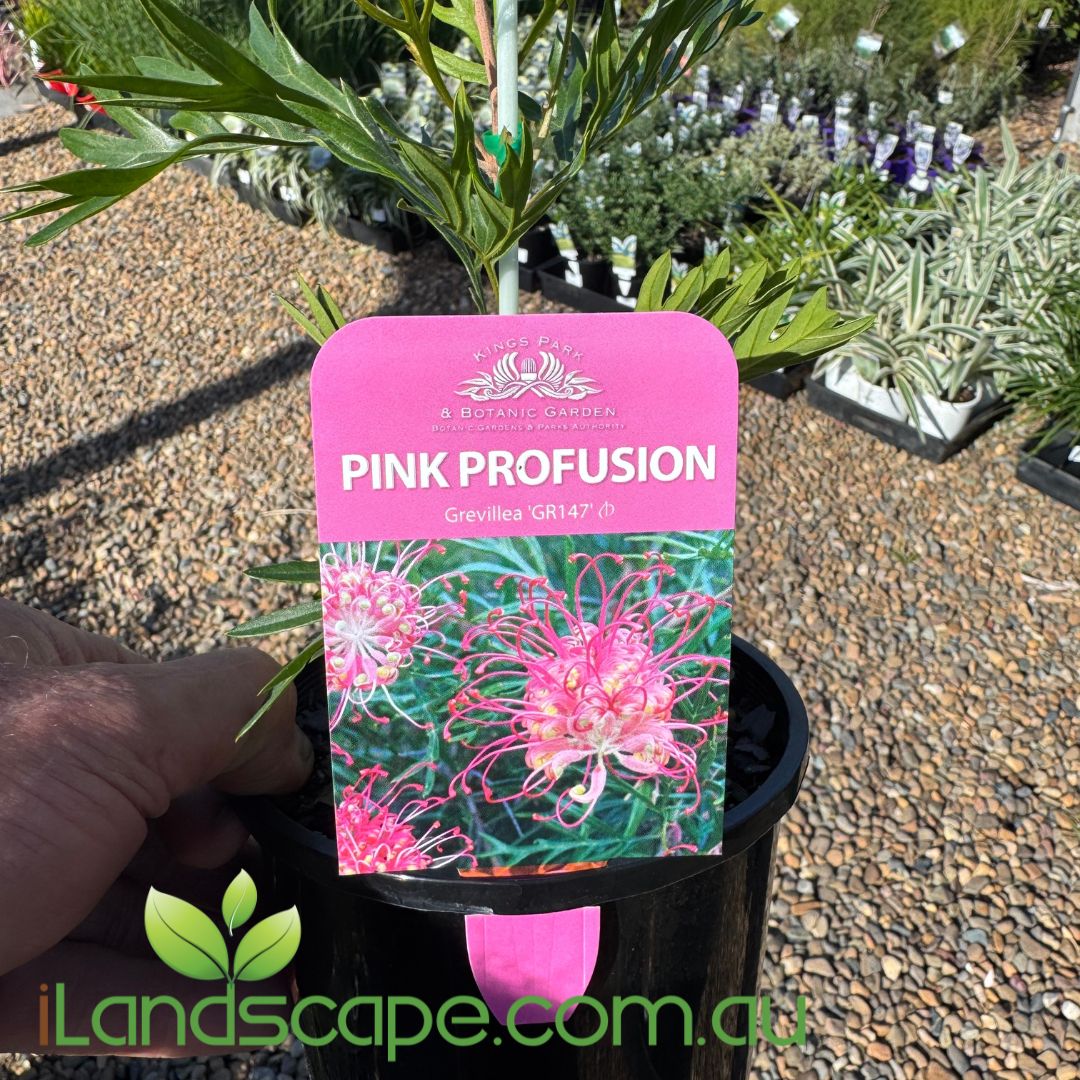
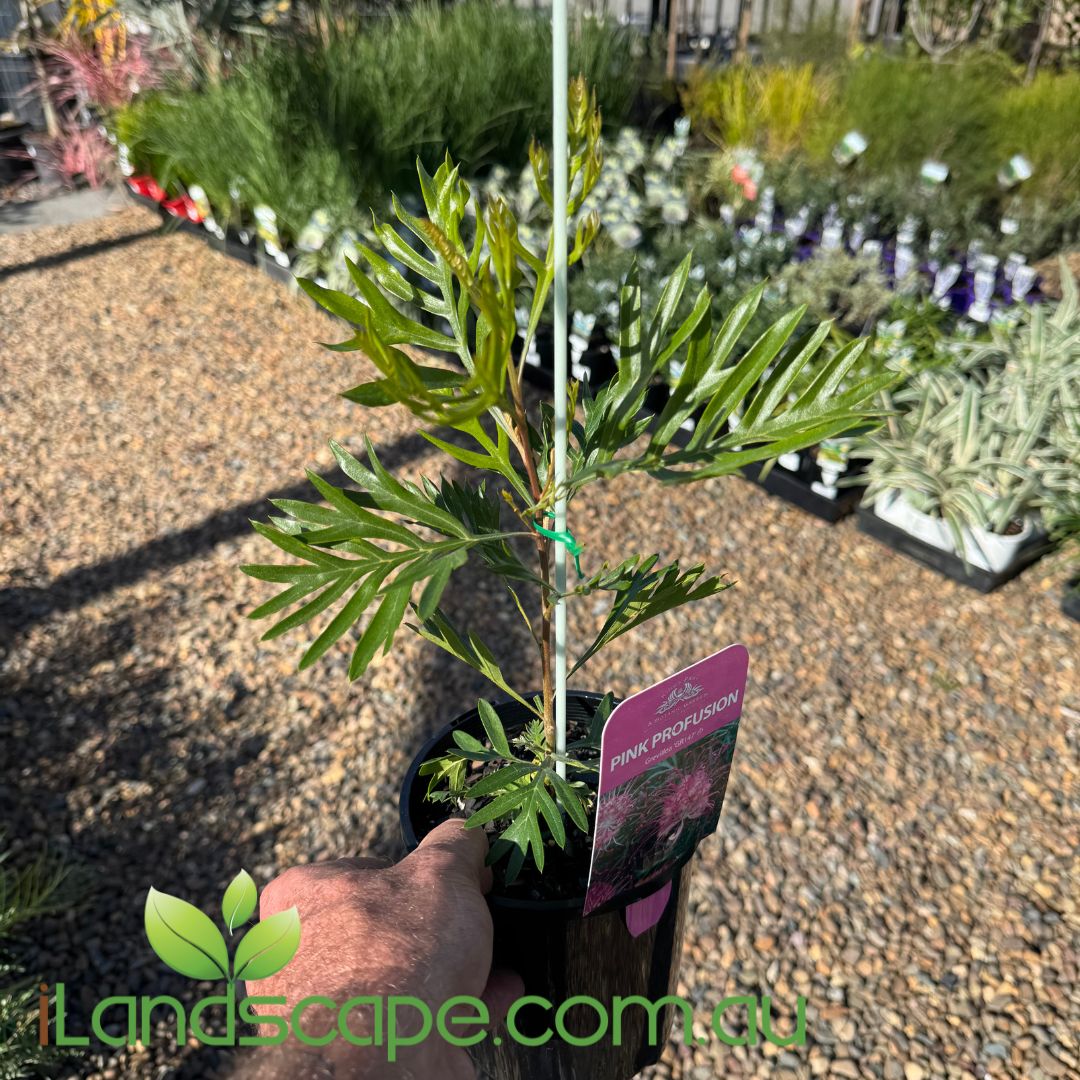
Description:
Grevillea 'Pink Profusion' is a vigorous, evergreen Australian native shrub renowned for its abundant pink flowers and fine, deeply divided foliage. This hybrid cultivar is a reliable performer in a wide range of climates and makes a striking feature in native gardens, bird-attracting landscapes, or informal hedging. Its dense habit and extended flowering season offer both beauty and biodiversity benefits year-round.
Flowers:
Produces vibrant, spider-style pink flowers for much of the year, with peak blooming in spring and autumn. The nectar-rich blooms are a magnet for honey-eating birds and beneficial pollinators.
Foliage:
Fine, ferny, grey-green foliage provides soft texture and year-round visual interest. The foliage contrasts beautifully with the vibrant flowers.
Fruit:
Small, inconspicuous seed pods may follow flowering but are not ornamental.
Form and Size:
Forms a dense, spreading shrub reaching approximately 1.5–2m high and 2–3m wide. Can be pruned to maintain a more compact shape or create a low screen.
Growing Conditions:
Thrives in full sun to part shade in well-drained soil. Tolerates dry conditions once established and is suitable for coastal gardens and frost-prone areas. Best performance is achieved with a light annual prune and low-phosphorus native fertiliser.
Uses:
Ideal for native gardens, wildlife-attracting landscapes, informal hedges, mixed borders, and low-maintenance screens. Excellent for erosion control and coastal planting.
Maintenance:
Low-maintenance once established. Light pruning after flowering helps maintain shape and encourages further blooming. Feed in spring with a slow-release, low-phosphorus fertiliser.
Notes:
Drought-tolerant and bird-friendly. May be lightly frost-tolerant depending on microclimate. Not suitable for heavy clay soils unless improved for drainage.
Companion Plants:
Pair with other native favourites such as Callistemon ‘Great Balls of Fire’, Lomandra ‘Tanika’, Westringia ‘Grey Box’, and Kangaroo Paw varieties for layered texture and colour.
Common Name: Grevillea 'Pink Profusion'
Botanical Name: Grevillea hybrid 'Pink Profusion'
Family: Proteaceae
Origin: Australian hybrid (cultivar)
Quantity:
check_circle In Stock
cancel Sold out
Get them before they sell out
Pay Less all year around for Tropical plants for your next gardening project. See Cordylines, Heliconias, Palms, Gingers and everything else you need instore and online plus we deliver.
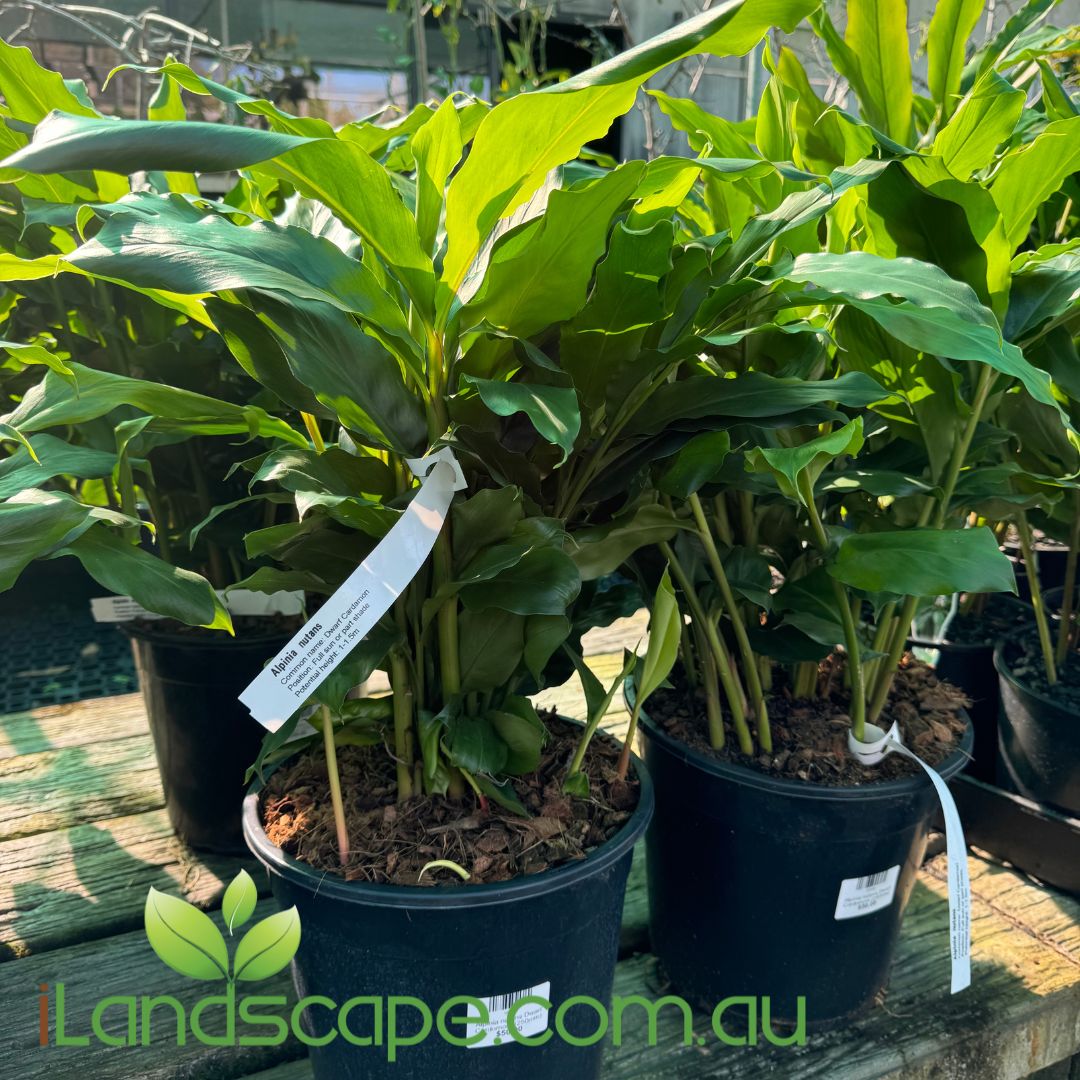
Alpinia nutans Dwarf Cardomom
Description Alpinia nutans, commonly known as Dwarf Cardamom, is a compact, evergreen perennial known for its aromatic foliage and attractive growth habit. This versatile plant is well-suited for garden beds, borders, and containers, providing a lush, tropical appearance and a delightful fragrance. Flowers Dwarf Cardamom produces small, white flowers with yellow and red markings that bloom in clusters. While the flowers are not the main ornamental feature, they add a delicate touch to the plant. Foliage The foliage of Alpinia nutans consists of broad, lance-shaped leaves that are glossy green and aromatic. When crushed, the leaves emit a pleasant, cardamom-like scent, adding sensory interest to the garden. Form and Size Dwarf Cardamom typically grows to a height of 60-90 cm with a similar spread. It forms a dense, clumping habit, making it ideal for use as a ground cover or in mass plantings. Growing Conditions Soil: Prefers well-drained, fertile soils rich in organic matter. It can tolerate a range of soil types but thrives in moist, loamy conditions. Sunlight: Grows best in partial shade to full shade. It can tolerate full sun in cooler climates but benefits from protection from the hot afternoon sun. Water: Requires regular watering to keep the soil consistently moist. It performs best with consistent moisture, especially during dry periods. Climate: Suitable for warm, temperate, and subtropical climates. It is frost-sensitive and should be protected from cold temperatures. Uses Ground Cover: Ideal for use as a ground cover, providing a dense, green carpet that suppresses weeds and adds visual interest. Borders and Edging: Perfect for borders and edging, where its compact size and lush foliage can create a neat and attractive outline. Containers: Can be grown in pots and containers, making it a versatile choice for patios, balconies, and small garden spaces. Herb Gardens: The aromatic foliage makes it a great addition to herb gardens and sensory gardens. Maintenance Pruning: Minimal pruning required. Remove any dead or damaged leaves to maintain appearance. Fertilizing: Benefits from regular applications of a balanced, slow-release fertilizer during the growing season. Pest and Disease: Generally pest-resistant but can be susceptible to aphids and spider mites. Monitor regularly and treat as needed. Notes Dwarf Cardamom is a charming and low-maintenance plant that adds a touch of tropical elegance to any garden or landscape. Its aromatic foliage and attractive growth habit make it a favorite among gardeners and landscapers. Companion Plants Zingiber zerumbet (Shampoo Ginger) Costus woodsonii (Red Button Ginger) Curcuma longa (Turmeric) Hedychium coronarium (White Ginger Lily) Common Name Dwarf Cardamom Botanical Name Alpinia nutans Family Zingiberaceae Origin Native to Southeast Asia, Alpinia nutans has been cultivated widely for its ornamental and aromatic foliage, making it a popular choice in gardens around the world.
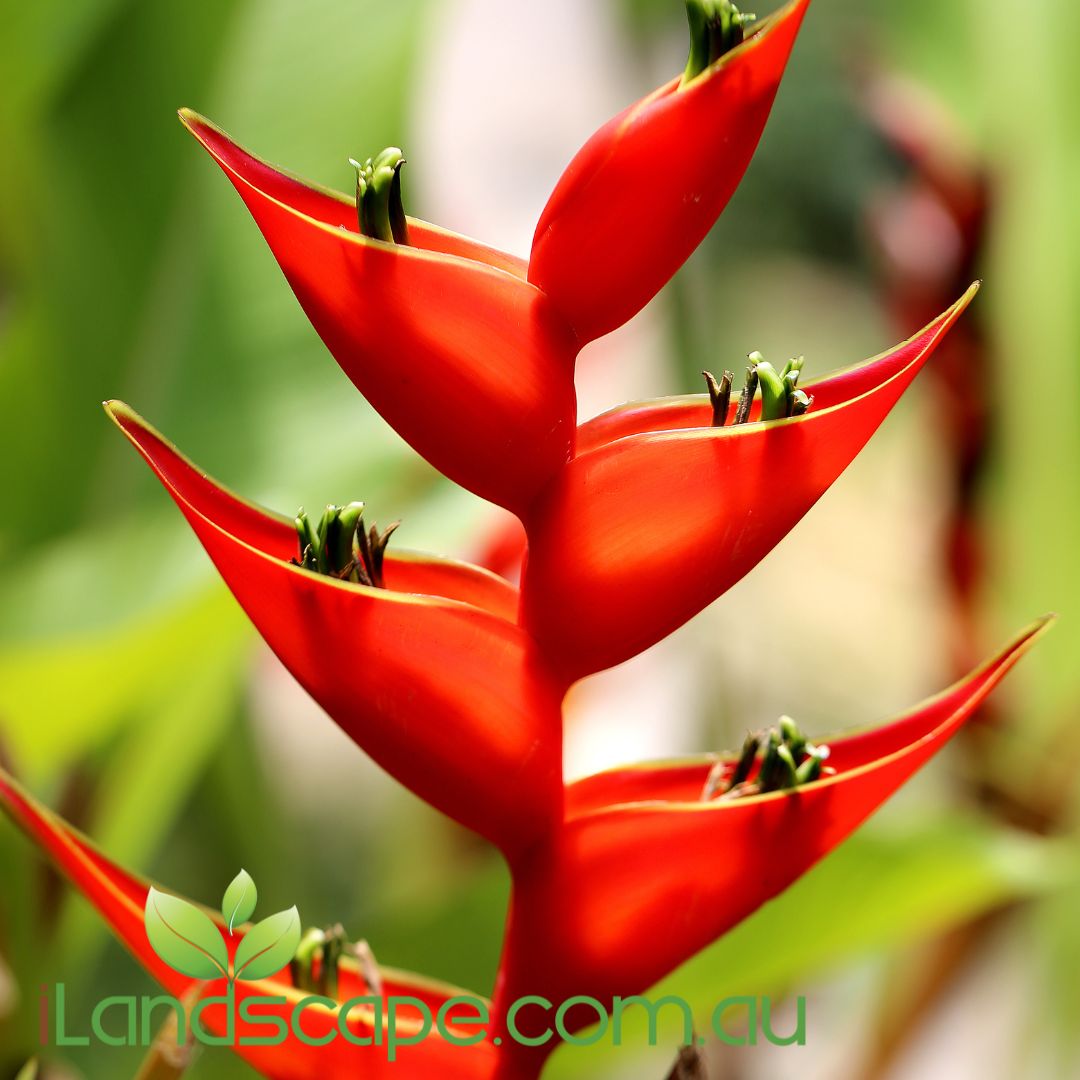
Heliconia Hot Rio Nights
Heliconia 'Hot Rio Nights' Description: Heliconia 'Hot Rio Nights' is a striking tropical plant known for its vibrant, exotic inflorescences and lush foliage. This variety is particularly noted for its tall, dramatic flower spikes that feature bold colors, making it a standout addition to any tropical garden or landscape. Flowers: The flowers of Heliconia 'Hot Rio Nights' are truly spectacular. They are arranged in large, upright inflorescences, with each bract displaying vivid shades of red, yellow, and orange. These eye-catching blooms can last for several weeks, providing continuous color throughout the blooming season. The flowers also attract hummingbirds and other pollinators. Foliage: The foliage of 'Hot Rio Nights' consists of large, banana-like leaves that are bright green and glossy. The leaves grow on tall, sturdy stems, creating a dense, tropical appearance. The broad, lush leaves add a touch of the exotic to any garden or landscape. Form and Size: Heliconia 'Hot Rio Nights' has an upright growth habit, typically reaching up to 1.5-2.5 meters (5-8 feet) in height and 1-1.5 meters (3-5 feet) in spread. Its bold, architectural form makes it an excellent choice for adding height and structure to garden beds and borders. Growing Conditions: Light: Prefers full sun to partial shade. It thrives in bright light but can tolerate some shade, especially in hotter climates. Soil: Well-draining, fertile soil rich in organic matter. A slightly acidic to neutral pH is ideal. Water: Keep the soil consistently moist, especially during the growing season. Ensure good drainage to prevent waterlogging. Once established, it can tolerate some drought. Temperature: Thrives in warm, tropical to subtropical climates. Hardy in USDA zones 10-11. Protect from frost and cold temperatures. Humidity: Prefers high humidity levels. Regular misting or placement near a humidity tray can help maintain the necessary moisture in the air if grown indoors. Uses: Heliconia 'Hot Rio Nights' is primarily grown for its ornamental value. It makes a stunning focal point in garden beds, borders, and large containers. The plant's vibrant blooms and lush foliage create a tropical feel, making it ideal for themed gardens and landscapes. It also makes a striking addition to cut flower arrangements due to its long-lasting inflorescences. Maintenance: This plant requires moderate maintenance. Regular watering and fertilization during the growing season will promote healthy growth. Prune away any dead or damaged leaves to maintain its appearance. Mulch around the base to conserve moisture and suppress weeds. Notes: Heliconia 'Hot Rio Nights' is non-toxic and safe to grow around pets and children. It is relatively pest-resistant but may occasionally attract aphids or spider mites, which can be treated with appropriate insecticides. Companion Plants: Heliconia 'Hot Rio Nights' pairs well with other tropical and subtropical plants that have similar growing requirements, such as: Bird of Paradise (Strelitzia reginae) Canna Lily (Canna indica) Ginger (Zingiber spp.) Elephant Ear (Colocasia esculenta) Common Name: Hot Rio Nights Botanical Name: Heliconia 'Hot Rio Nights' Family: Heliconiaceae Origin: Hybrid, developed in cultivation
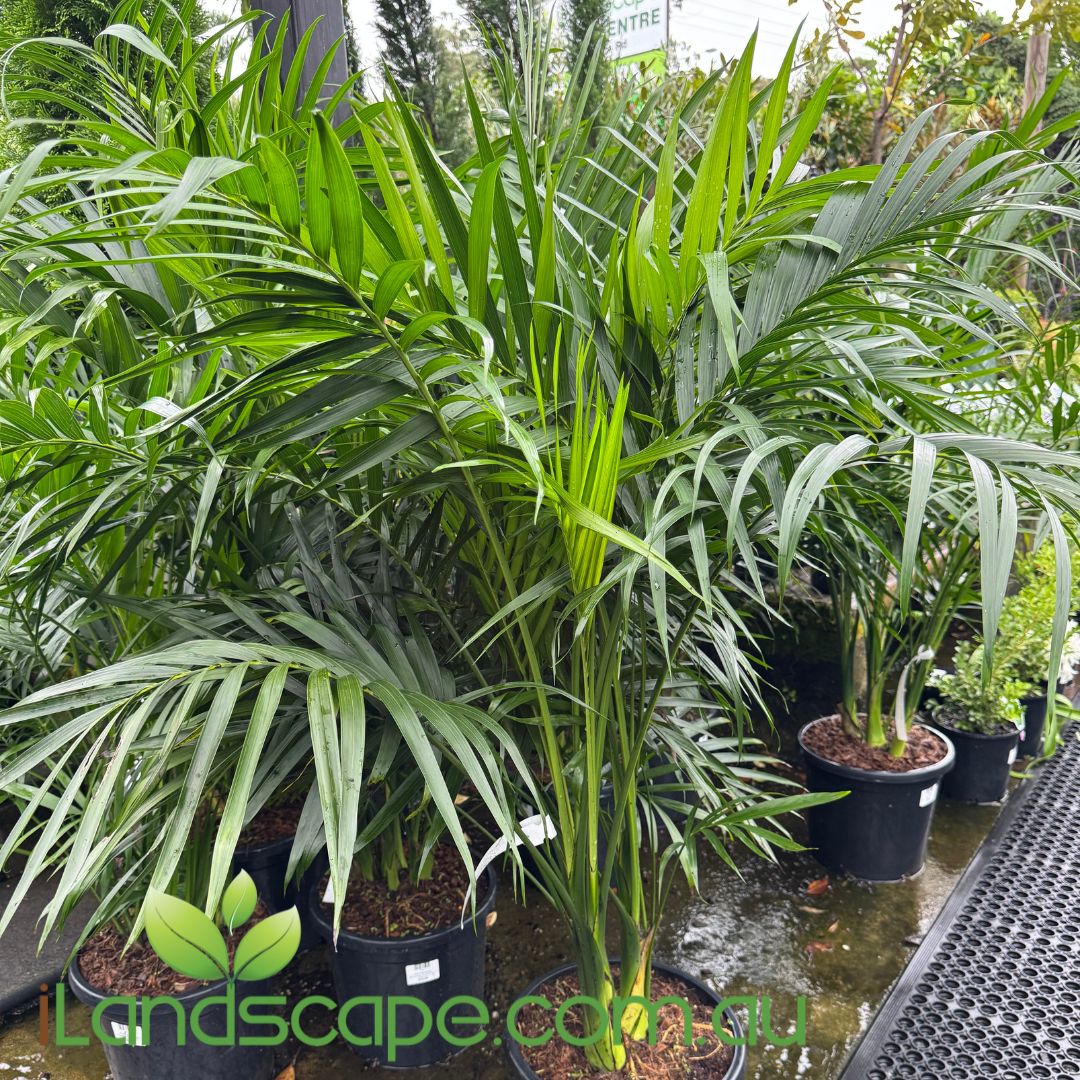
Chamaedorea Atrovirens (Cascade palm)
Description Chamaedorea atrovirens, commonly known as the Cascade Palm or Cat Palm, is a small to medium-sized palm that is popular for indoor and outdoor decoration. It features a clumping growth habit with multiple thin, bamboo-like stems and graceful, arching fronds that give it a lush, tropical appearance. This palm is well-suited to both bright and low-light conditions, making it a versatile choice for various environments. Flowers The Cascade Palm produces small, yellowish flowers on inflorescences that emerge from the leaf axils. These flowers are not particularly showy and are often hidden among the foliage. Foliage The leaves are pinnate, with multiple narrow leaflets arranged along a central stem. The fronds are bright green, creating a dense and vibrant display of foliage. Each frond can grow up to 1 meter in length, adding to the plant's lush and tropical look. Fruit In its natural habitat, Chamaedorea atrovirens can produce small, round, black fruits. However, fruiting is rare when grown indoors. Form and Size The Cascade Palm grows in a clumping form, with multiple stems arising from the base. It typically reaches a height of 1.5-2 meters when grown indoors, though it can grow taller under optimal conditions. The plant spreads slowly and maintains a manageable size, making it ideal for indoor spaces. Growing Conditions Light: Prefers bright, indirect light but can tolerate low light conditions. Avoid direct sunlight, which can scorch the leaves. Water: Keep the soil consistently moist but not waterlogged. Allow the top inch of soil to dry out between waterings. Humidity: Thrives in high humidity environments. Regular misting can help maintain adequate humidity levels, especially in dry indoor conditions. Temperature: Prefers temperatures between 15-25°C. Avoid exposing the plant to drafts or sudden temperature changes. Uses Chamaedorea atrovirens is ideal for: Indoor decoration in homes and offices Adding greenery to shaded garden areas Creating a tropical ambiance in interior spaces and patios Maintenance Pruning: Remove any yellow or damaged fronds to maintain the plant's appearance. Trim back any overly long stems to encourage bushier growth. Repotting: Repot every 2-3 years in spring to refresh the soil and provide more space for growth. Use a well-draining potting mix. Pests: Watch for common indoor pests such as spider mites, scale, and mealybugs. Treat infestations promptly with insecticidal soap or neem oil. Notes The Cascade Palm is non-toxic to pets, making it a safe choice for households with animals. It is also known for its air-purifying qualities, helping to improve indoor air quality. Companion Plants Dracaena Ficus Philodendron Pothos These plants share similar care requirements and can complement the Cascade Palm in creating a lush, tropical indoor garden. Chamaedorea Atrovirens (Cascade Palm) Common Name Cascade Palm, Cat Palm Botanical Name Chamaedorea atrovirens Family Arecaceae Origin Native to the tropical and subtropical regions of Mexico and Central America.
we have a great range of plants that grow under 1.0m - All grown locally and sun hardened

Syzygium Plum Magic
Syzygium ‘Plum Magic’ is a striking, compact Australian native shrub celebrated for its vibrant plum-coloured new growth and dense evergreen foliage. Perfect for hedges, borders, and feature planting, this hardy variety delivers year-round greenery and spectacular bursts of seasonal colour, making it ideal for both modern and native-themed landscapes. Flowers Produces clusters of creamy-white fluffy flowers in summer, followed by small fleshy pink berries that attract birds and provide extra ornamental appeal. Foliage Features glossy green mature leaves complemented by stunning plum-purple to deep burgundy new growth. The colourful flushes create striking contrast and add visual interest throughout the year. Fruit Develops small pinkish-red berries after flowering, which are highly attractive to native birds and wildlife. Form & Size A compact, upright shrub typically growing to around 2–3 m high and 1.5–2 m wide, making it perfect for hedging, screening, or mass planting. Growing Conditions Light: Thrives in full sun but tolerates part shade Soil: Prefers well-drained soils, tolerates sandy and clay soils once established Water: Moderate water needs; drought-tolerant when established Climate: Performs well in coastal, inland, and subtropical regions Uses Excellent for hedging, screening, and privacy planting Perfect for feature planting to highlight its colourful new growth Ideal for formal gardens, native landscapes, and mixed borders Suitable for large pots and containers when pruned regularly Maintenance Light pruning after flowering encourages compact growth and maintains shape Fertilise with a low-phosphorus native fertiliser in spring and summer Mulch around the base to retain moisture and suppress weeds Notes Known for its vibrant plum-coloured flushes and year-round appeal Non-invasive and adaptable to a range of garden styles Common Name: Plum Magic Lilly PillyBotanical Name: Syzygium ‘Plum Magic’Family: MyrtaceaeOrigin: Australia
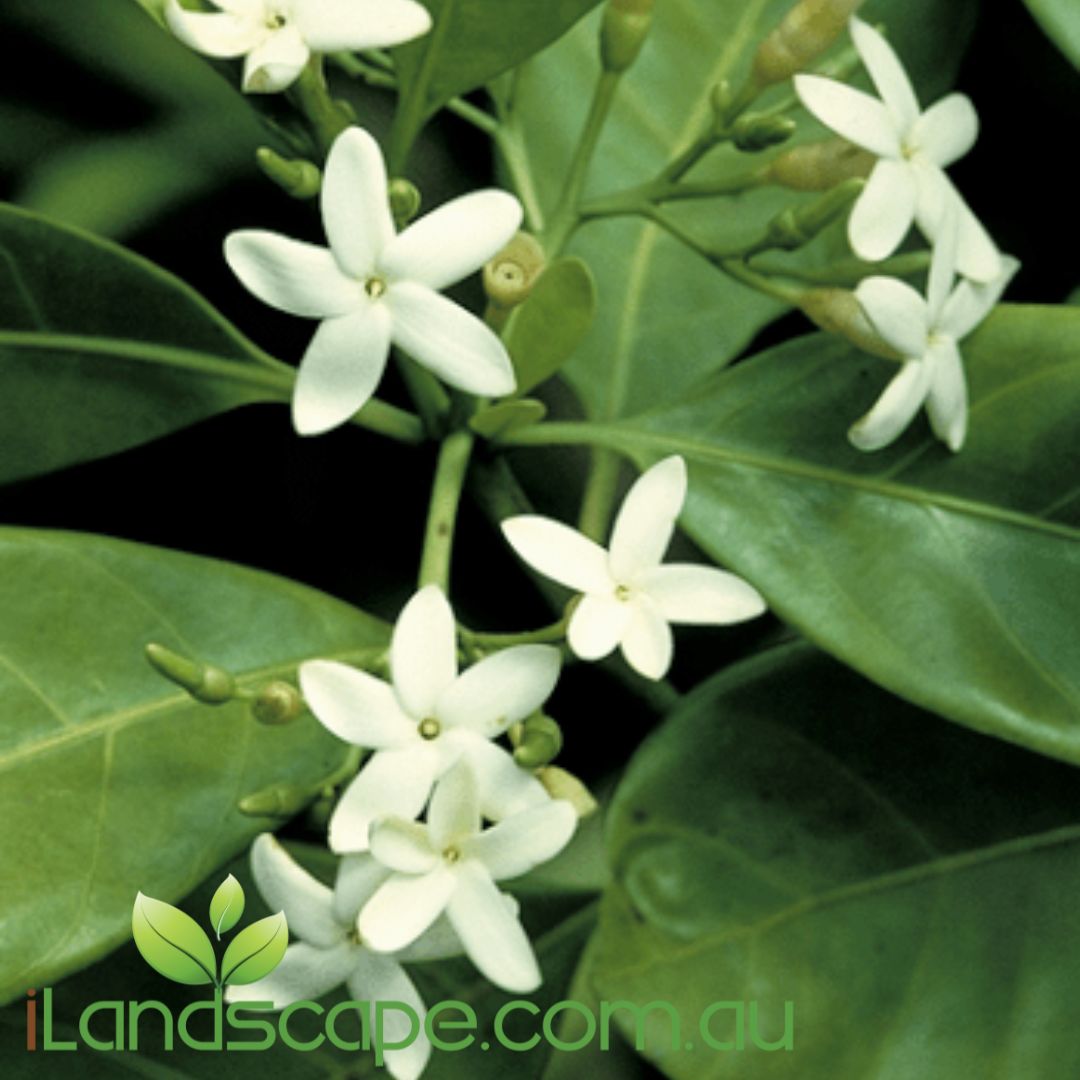
Randia Fitzalanii - Native Gardenia
Randia fitzalanii, commonly known as Native Gardenia, is a beautiful evergreen shrub or small tree native to tropical and subtropical regions of Australia. Known for its lush, glossy foliage and highly fragrant white flowers, this plant makes a stunning addition to native, rainforest-inspired, or formal gardens. Its neat, rounded habit and ornamental appeal make it perfect for feature planting or hedging in both urban and rural landscapes. FlowersCreamy-white, star-shaped flowers bloom in spring to summer and emit a strong, sweet gardenia-like fragrance, particularly noticeable in the evenings. The blooms are highly attractive to bees and other pollinators. FoliageDark green, glossy, and oval-shaped leaves form a dense canopy, creating a lush tropical appearance. The foliage remains attractive year-round and responds well to light pruning. FruitProduces small, round, yellow to orange fruit following flowering. The fruit is edible (though not widely consumed), and attracts native birds and wildlife. Form and SizeTypically grows as a shrub to small tree, reaching 3–5m high x 2–3m wide, but can be pruned to maintain a smaller size or shaped into a dense hedge. It has a rounded, compact growth habit. Growing ConditionsPrefers full sun to part shade and well-drained, fertile soil rich in organic matter. Tolerates light frost and periods of dryness once established but performs best with regular moisture. Suitable for tropical, subtropical, and warm temperate climates. UsesIdeal for feature planting, informal hedging, screening, or as a specimen tree in native or tropical-style gardens. Also works well in large pots or near patios where its fragrance can be enjoyed up close. MaintenanceLow to moderate maintenance. Prune lightly after flowering to maintain shape and encourage bushiness. Apply slow-release fertiliser in spring and mulch well to conserve moisture and improve soil health. NotesA great native alternative to exotic gardenias, offering similar fragrance with better adaptability to Australian conditions. Provides excellent habitat value for birds and insects. Companion PlantsWorks beautifully alongside Backhousia citriodora, Syzygium australe, Cordyline fruticosa, Alpinia nutans, or Dianella caerulea to enhance native or subtropical plantings. Common Name: Native GardeniaBotanical Name: Randia fitzalaniiFamily: RubiaceaeOrigin: Northern and eastern Australia
Want to Stage your house with some cool pots and large indoor or shaded plants - come on down and check these out
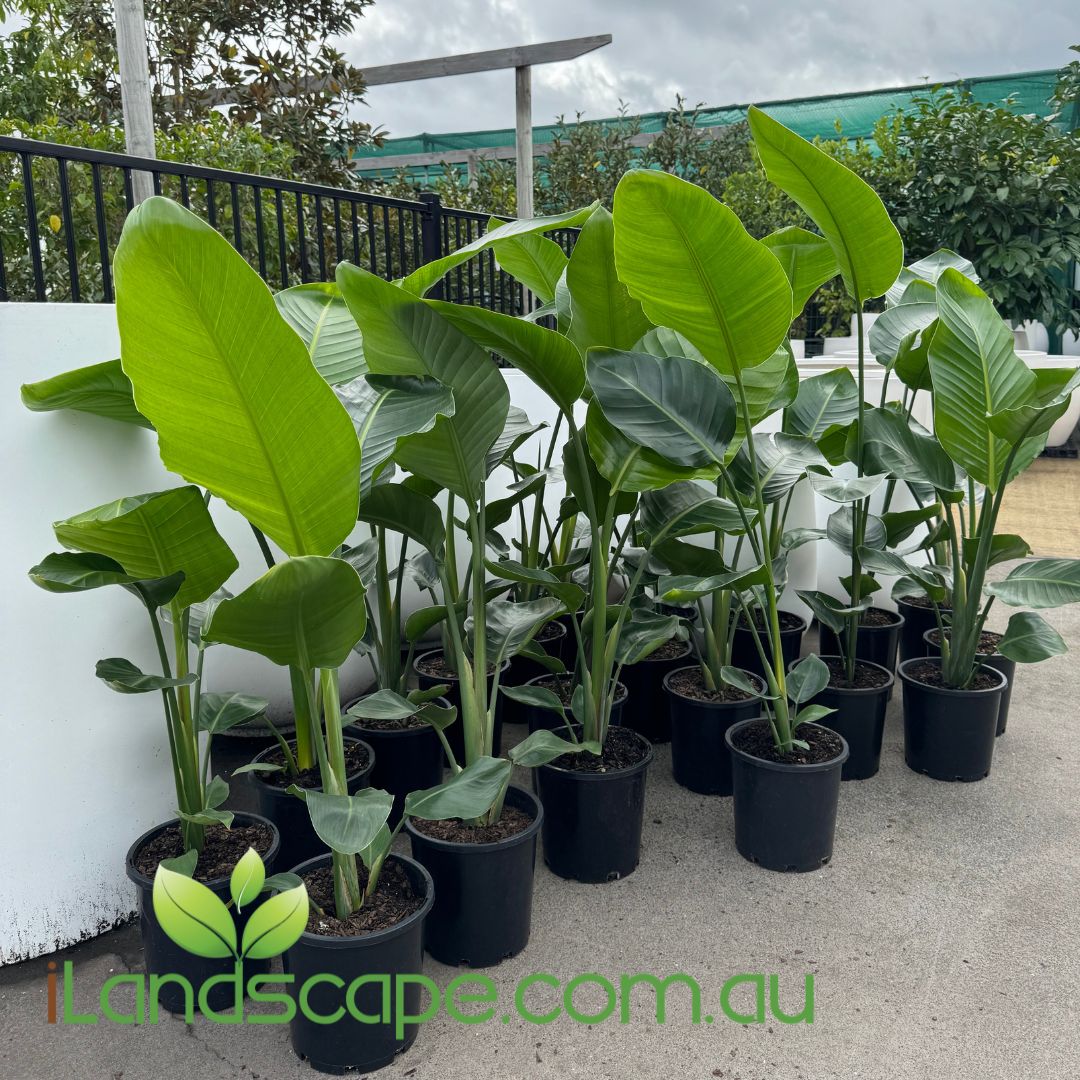
Strelitzia Nicolai
Description Strelitzia nicolai, commonly known as the Giant White Bird of Paradise or Wild Banana, is a striking, large tropical plant known for its lush, banana-like leaves and dramatic, bird-like flowers. It can grow into a substantial plant, adding a touch of the exotic to both indoor and outdoor spaces. Please Note: We recommend only using these plants in Pots, their roots are invasive and will damage the surrounding area. if you have a larger more open space away from homes, pipes and infrastructure etc, these plants are fine Flowers The flowers of Strelitzia nicolai are large and white with a blue tongue, emerging from a dark, beak-like spathe that resembles the head of a bird. These flowers appear on tall, sturdy stalks and are stunningly ornamental. Flowering usually occurs in spring and summer but may not appear on indoor plants. Foliage The leaves are large, leathery, and paddle-shaped, growing up to 2 meters (6.5 feet) long. They are dark green and arranged in a fan-like pattern, giving the plant a tropical and architectural look. Fruit The plant can produce fruit, which are woody capsules containing black seeds with orange arils. However, this is more common in its natural habitat and less so in indoor settings. Form and Size Strelitzia nicolai has a clumping growth habit and can reach a height of 6-12 meters (20-40 feet) in its native habitat. When grown indoors, it typically reaches about 2-3 meters (6-10 feet), making it a striking specimen plant. Its spread can be equally wide, so it needs ample space to grow. Growing Conditions Light: Prefers bright, indirect light but can tolerate some direct sunlight. Insufficient light can slow growth and reduce leaf size. Water: Keep the soil consistently moist but not waterlogged. Allow the top inch of soil to dry out between waterings. Reduce watering in winter. Humidity: Thrives in high humidity. Regular misting or using a humidity tray can help maintain adequate humidity levels. Temperature: Prefers temperatures between 18-27°C (65-80°F). Protect from cold drafts and frost, as it is sensitive to cold. Uses Strelitzia nicolai is perfect for: Indoor decoration in large, well-lit spaces Creating a tropical ambiance in homes and offices Outdoor landscaping in tropical and subtropical climates Atriums and conservatories Maintenance Pruning: Remove any yellow or damaged leaves to maintain the plant's appearance. Cut back old flower stalks to encourage new growth. Repotting: Repot every 2-3 years or when the plant becomes root-bound. Use a well-draining potting mix rich in organic matter. Pests: Generally pest-resistant but can occasionally be affected by spider mites, mealybugs, or scale. Treat infestations promptly with insecticidal soap or neem oil. Notes Strelitzia nicolai is non-toxic to humans but mildly toxic to pets if ingested, causing mild stomach upset. Its large size and striking appearance make it a focal point in any space. Companion Plants Monstera deliciosa Ficus lyrata (Fiddle Leaf Fig) Philodendron varieties Alocasia These plants share similar care requirements and can complement the Strelitzia nicolai in creating a lush, tropical indoor garden. Strelitzia nicolai Common Name Giant White Bird of Paradise, Wild Banana Botanical Name Strelitzia nicolai Family Strelitziaceae Origin Native to the coastal regions of South Africa.
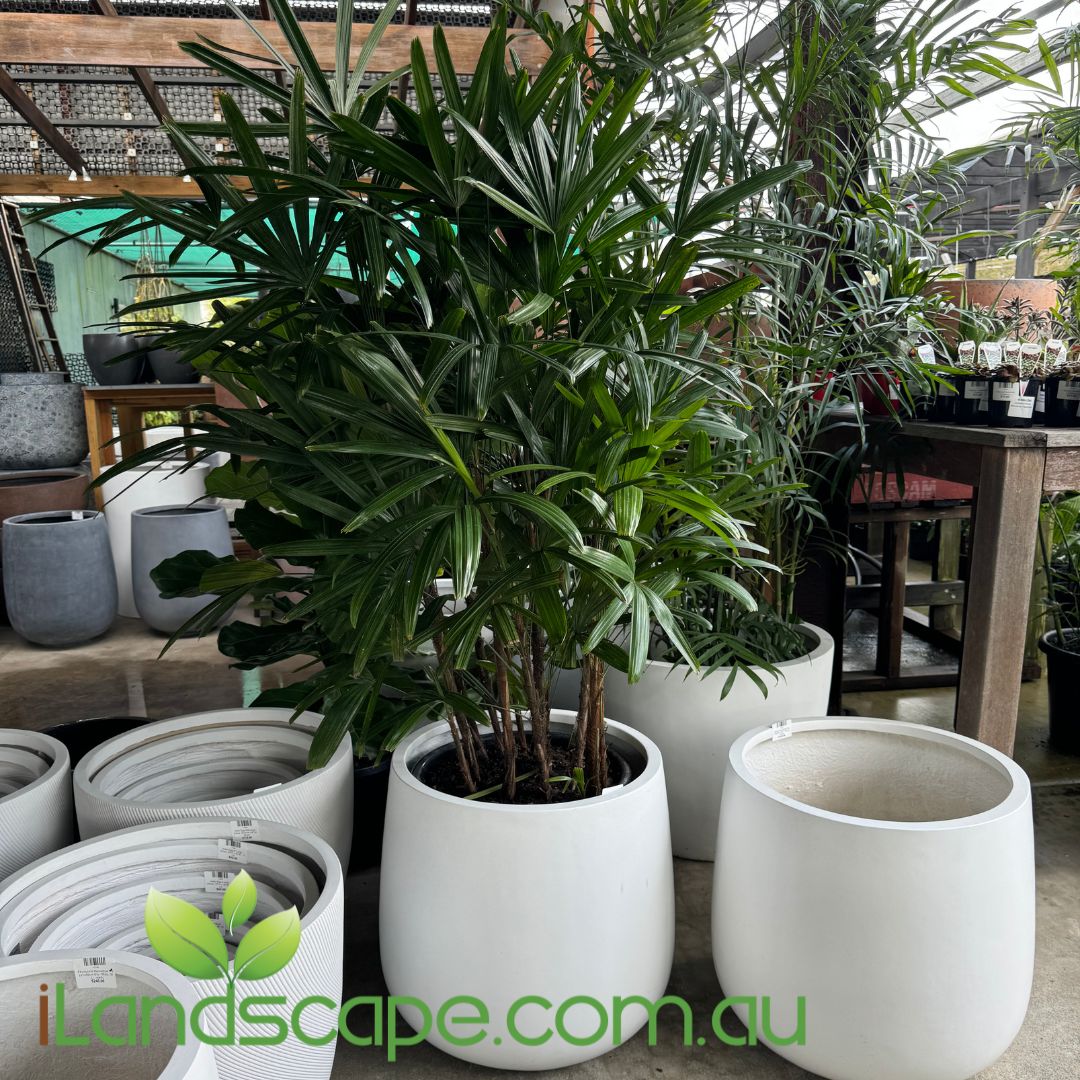
Rhapis Palm - Lady Palm
Rhapis Palm Description:The Rhapis Palm, commonly known as Lady Palm, is an elegant, slow-growing palm species known for its fan-like fronds and compact, clumping habit. This versatile palm is highly valued for its refined appearance, making it an excellent choice for indoor settings, patios, and tropical garden landscapes. Foliage:The foliage of the Rhapis Palm consists of dark green, fan-shaped fronds divided into narrow segments. The fronds are supported by slender, bamboo-like stems that give the plant a graceful, airy appearance. The dense foliage adds a lush, tropical ambiance to any environment, whether grown indoors or outdoors. Form and Size:The Rhapis Palm has a clumping growth habit and typically reaches up to 1.5-3 meters (5-10 feet) in height and 1-2 meters (3-6.5 feet) in spread. Its moderate size and tidy growth make it ideal for use as an indoor plant, a patio feature, or a low hedge in shaded garden areas. Growing Conditions: Light: Prefers partial to full shade. It thrives in low light conditions, making it an excellent choice for indoor environments or shaded outdoor spaces. Soil: Well-draining, fertile soil rich in organic matter. It can tolerate a range of soil types but prefers slightly acidic to neutral pH. Water: Moderate water requirements. Keep the soil consistently moist, allowing the top few centimeters to dry out between watering. Reduce watering during cooler months. Temperature: Prefers warm, humid conditions. Hardy in USDA zones 9-11. Protect from frost and cold drafts if grown indoors. Humidity: Thrives in moderate to high humidity. Regular misting or the use of a humidity tray can help maintain the necessary moisture in drier indoor environments. Uses:The Rhapis Palm is primarily grown for its ornamental value and versatility. It makes an excellent indoor plant, adding a touch of greenery to homes and offices. Outdoors, it can be used as a hedge, screen, or understory plant in shaded garden areas. Its elegant form and compact size also make it a popular choice for container planting on patios and balconies. Maintenance:This plant is relatively low-maintenance. Prune away any yellow or damaged fronds to maintain its appearance. Fertilize lightly during the growing season with a balanced, slow-release fertilizer. Repot every few years as needed to refresh the soil and provide room for growth. Notes:The Rhapis Palm is non-toxic and safe to grow around pets and children. It is also relatively pest-resistant but may occasionally attract spider mites or scale insects, which can be treated with appropriate insecticides. Companion Plants:The Rhapis Palm pairs well with other shade-tolerant plants that have similar growing requirements, such as: Aspidistra elatior (Cast Iron Plant) Aglaonema species Ferns (such as Nephrolepis exaltata) Dracaena species Common Name: Lady PalmBotanical Name: Rhapis excelsaFamily: ArecaceaeOrigin: Native to southern China and Taiwan, widely cultivated as an ornamental plant
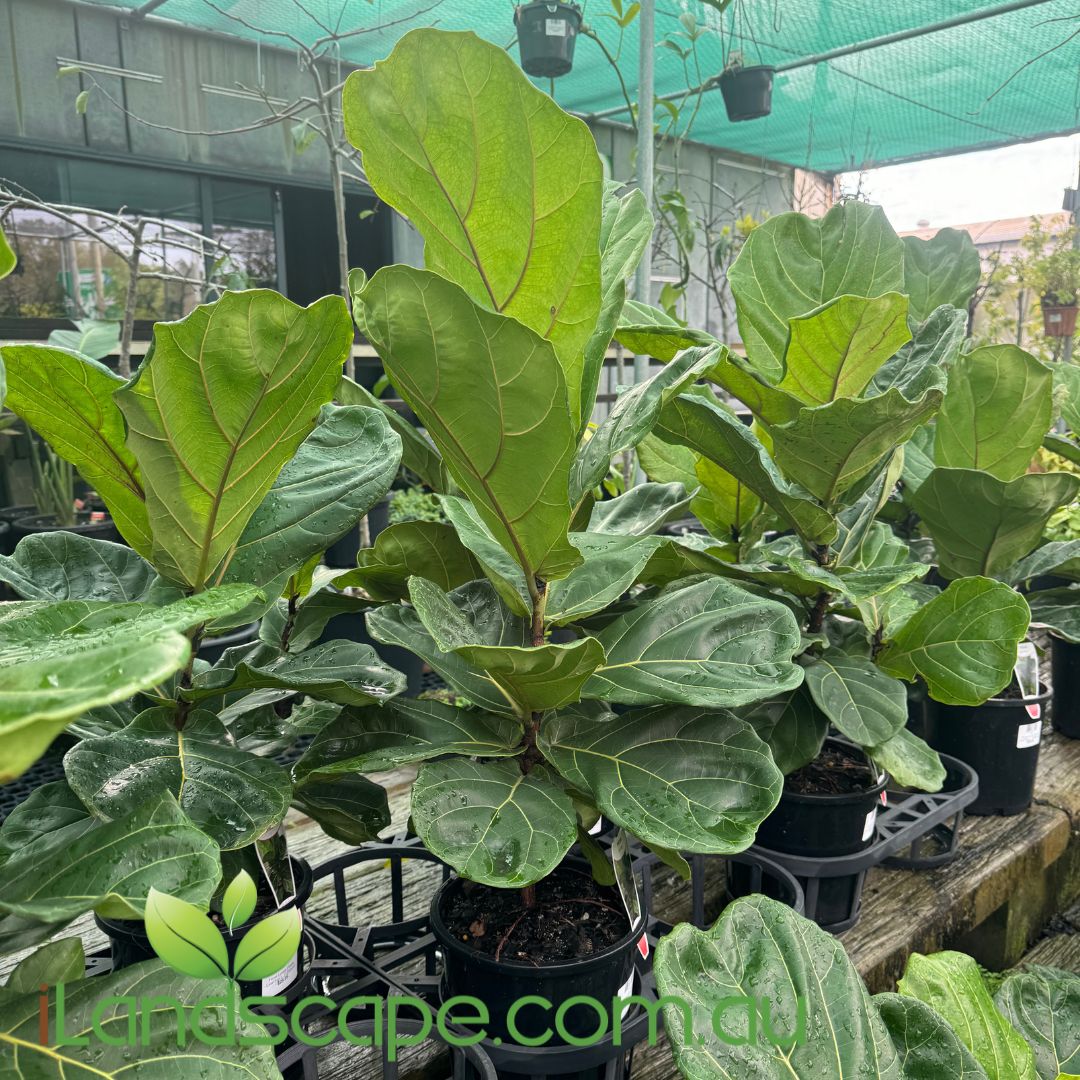
Ficus Lyrata (Fiddle Leaf Fig)
Ficus Lyrata more commonly known as the Fiddle Leaf Fig. mainly used in indoor planting however can be planted outside in full sun where in the ground can grow to approx 10-15m tall. one of the most common problems when looking after a fiddle leaf fig is over watering. we recommend one good watering then let the plant dry out before watering again. Rotate the plant once a week if growing indoors and it will keep growing straight and not want to lean towards the light

Aglaonema Red Valentine
Aglaonema 'Red Valentine' Description: Aglaonema 'Red Valentine', also known as Chinese Evergreen, is a vibrant indoor plant celebrated for its striking, colourful foliage. This variety, 'Red Valentine', features beautiful leaves with shades of pink and red mixed with green, adding a bold splash of colour to any indoor space. It is highly valued for its decorative appeal and low-maintenance care. Flowers: The flowers of Aglaonema 'Red Valentine' are small and inconspicuous, consisting of a spathe and spadix typical of the Araceae family. While the flowers are not particularly showy, they can add a subtle ornamental touch when they appear. Foliage: The foliage of Aglaonema 'Red Valentine' is its main attraction. The broad, lance-shaped leaves display a stunning combination of pink, red, and green. The vibrant colours and patterns make this plant a standout in any indoor setting. The leaves grow densely from the base, creating a lush, full appearance. Form and Size: Aglaonema 'Red Valentine' has a compact, clumping growth habit, typically reaching up to 50-60 cm (20-24 inches) in height and spread. Its manageable size makes it perfect for indoor spaces, including living rooms, offices, and bedrooms. Growing Conditions: Light: Prefers low to moderate indirect light. It can tolerate low light conditions, making it ideal for indoor environments. Avoid direct sunlight as it can scorch the leaves. Soil: Well-draining, peat-based potting mix. Water: Keep the soil consistently moist but not waterlogged. Allow the top inch of soil to dry out between watering's. Aglaonema also appreciates regular misting to maintain humidity. Temperature: Thrives in temperatures between 18-27°C (65-80°F). Avoid cold drafts and temperatures below 15°C (60°F). Humidity: Prefers high humidity levels. Regular misting or placement near a humidity tray can help maintain the necessary moisture in the air. Uses: Aglaonema 'Red Valentine' is primarily used as an ornamental houseplant. Its vibrant foliage and compact size make it an excellent choice for adding a touch of colour to indoor spaces. It is also known for its air-purifying abilities, helping to remove toxins like benzene, formaldehyde, and ammonia from the air. Maintenance: This plant is relatively low-maintenance. Regularly wipe the leaves with a damp cloth to remove dust and maintain their shine. Remove any spent flowers and yellowing leaves to keep the plant looking its best. Repot every 2-3 years to refresh the soil and provide more space for growth. Notes: Aglaonema 'Red Valentine' is toxic if ingested, so it should be kept out of reach of pets and children. Handle the plant with care, as the sap can cause skin irritation in sensitive individuals. Companion Plants: Aglaonema 'Red Valentine' pairs well with other low-light tropical plants that have similar care requirements, such as: ZZ Plant (Zamioculcas zamiifolia) Snake Plant (Sansevieria trifasciata) Pothos (Epipremnum aureum) Philodendron species Common Name: Red Valentine, Chinese Evergreen Botanical Name: Aglaonema 'Red Valentine' Family: Araceae Origin: Native to Southeast Asia, cultivated as a popular indoor plant variety
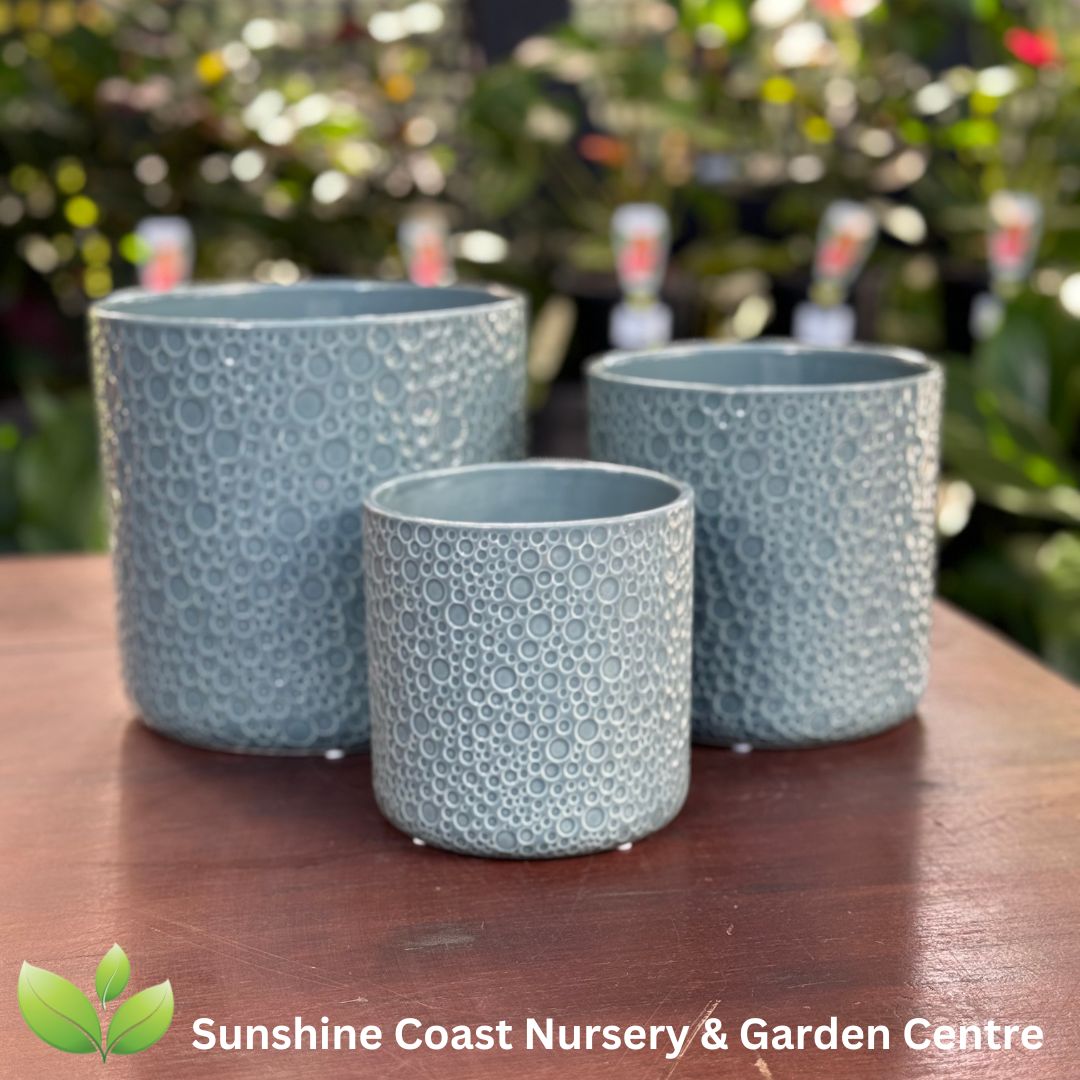
Dots Cylinder Pot
Dots Cylinder Pots will bring your indoor plants to life with their cool pattern and beautiful colours are available in 3 x colours and 3 x sizes Small - 13cm x 13cm Medium - 16cm x 16cm Large - 19cm x 19cm Colours Blue, Grey & White
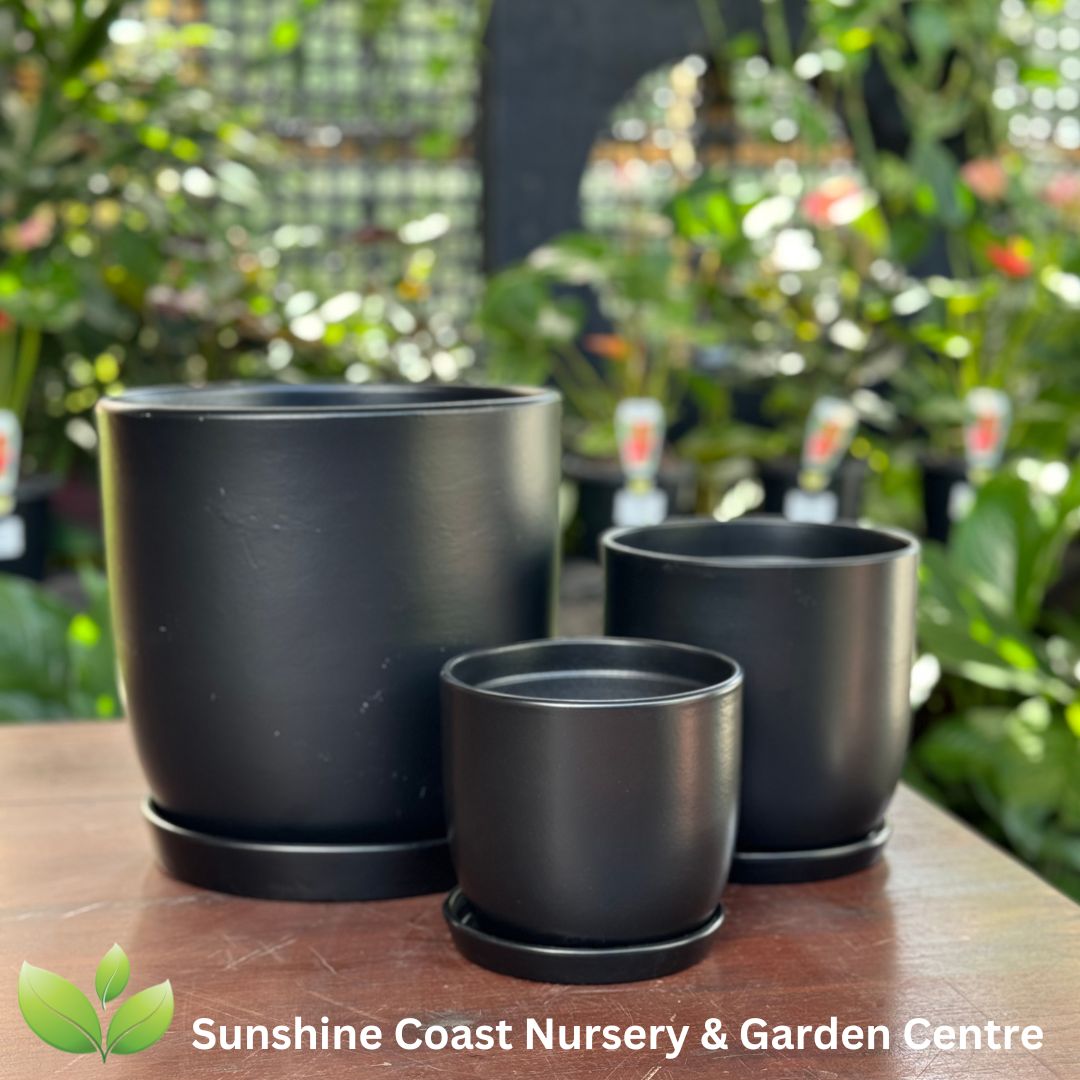
Jessa Egg Pot
Jessa Egg Pots are an amazing priced indoor pot set that come with a colour matching Saucer they are available in 2 x colours and 3 x sizes Small - 14cm x 14cm Medium - 17cm x 17cm Large - 25cm x 25cm Colours - Black & White
Sale
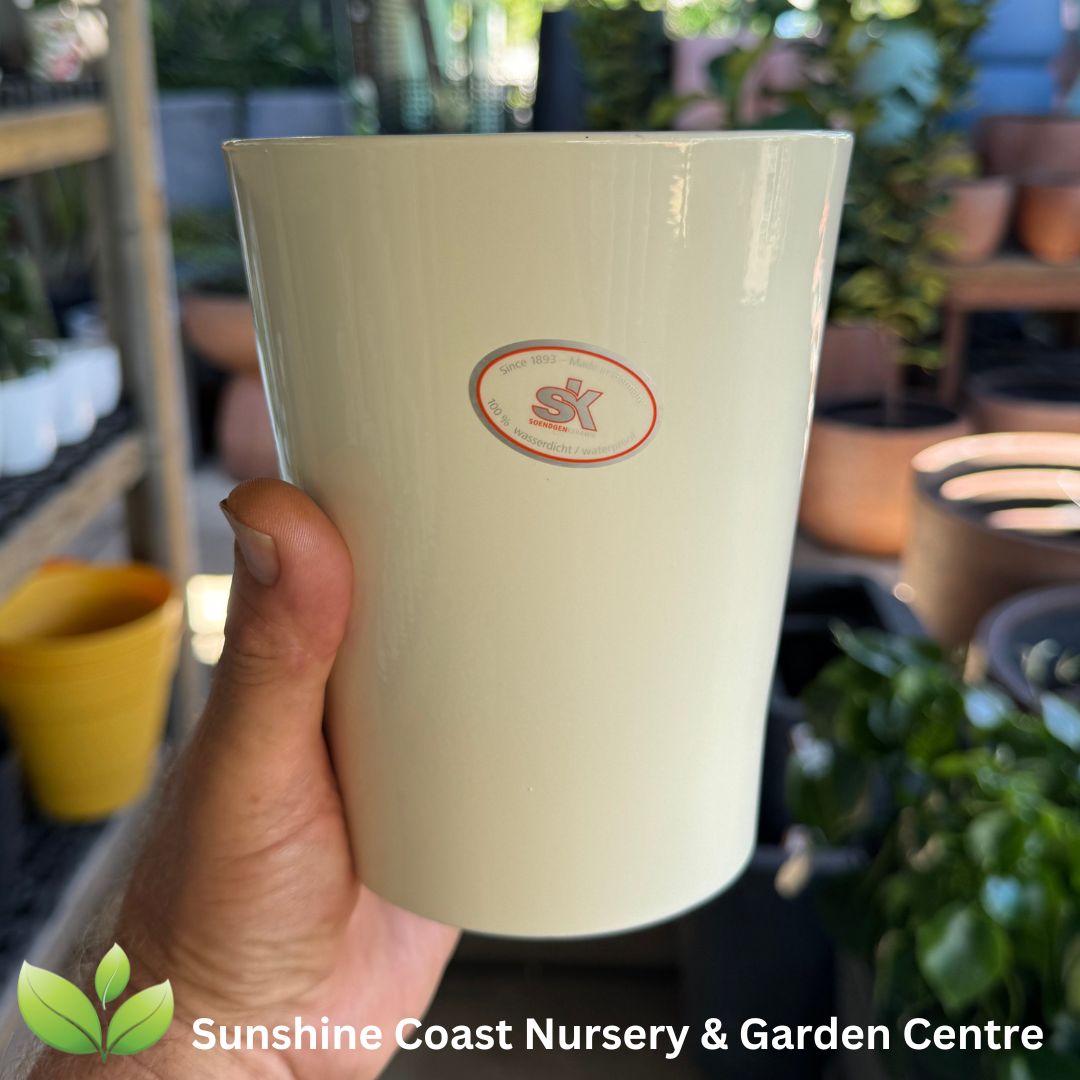
Merina Indoor Orchid Pot
Beautifully German made indoor pots that suit 100mm or 125mmpoly pots which make them perfect for displaying any small indoor plant or orchid Available in Multiple colours please hit us up using the chat button to see what we have in stock in the Sunshine Coast Nursery & Garden centre
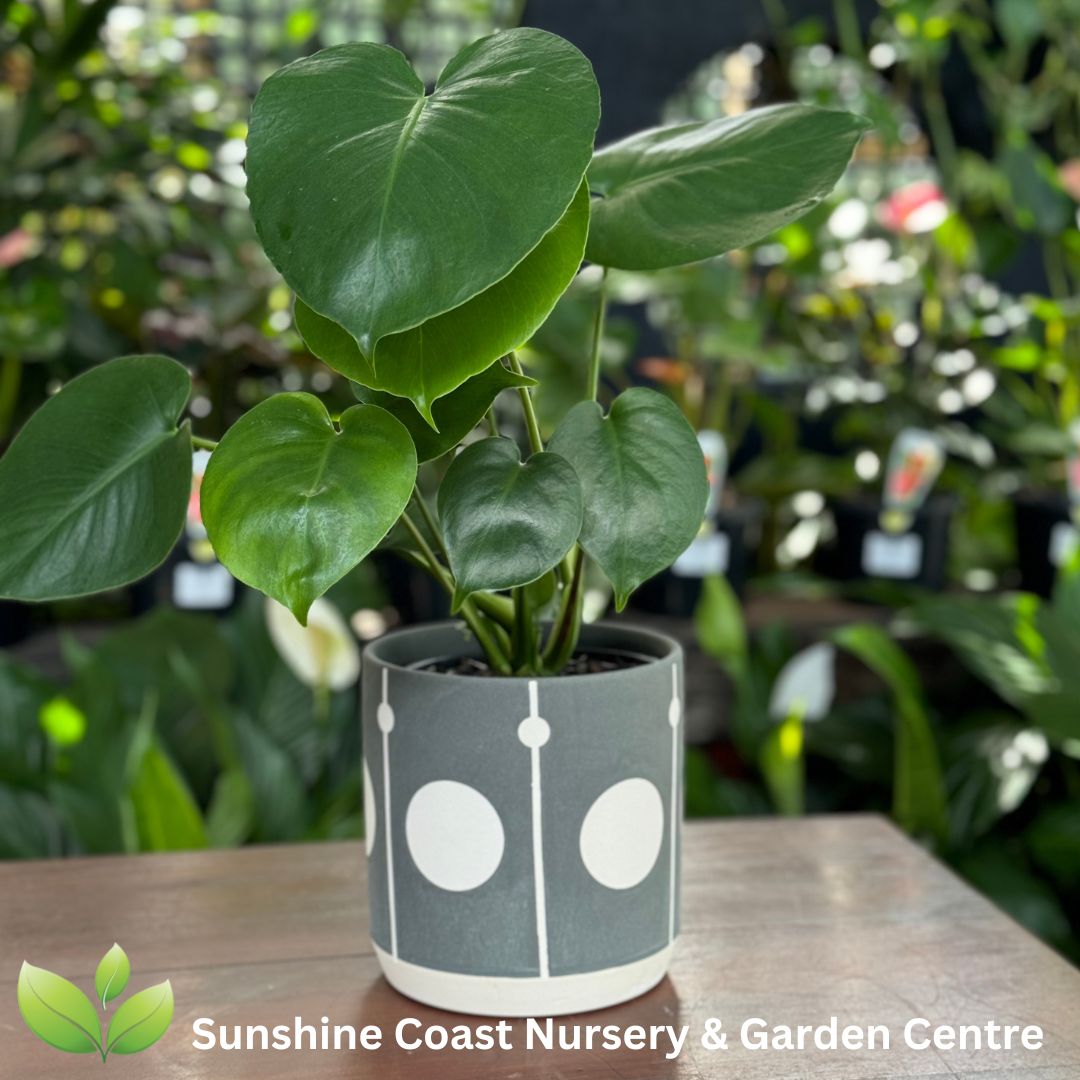
Osana Pot
Osana Pots will bring your indoor plants to life with their cool pattern and beautiful colours are available in 2 x colours and 1 x sizes Small - 16cm x 16.5cm Colours Blush & Grey
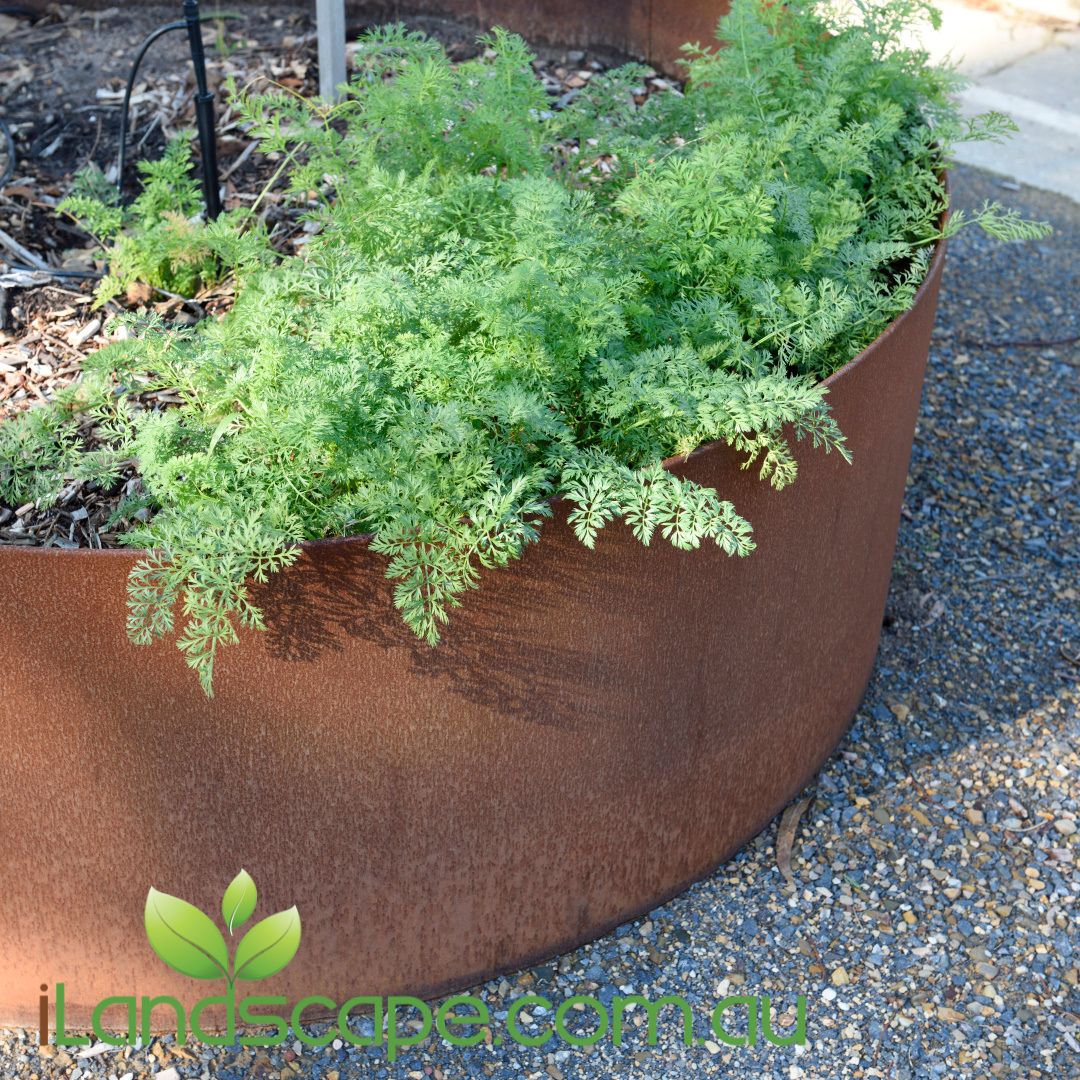
Redcor Garden Edging X 2.4m Lengths
Introducing BlueScope® REDCOR® steel, the Australian Made “corten” weathering steel Proudly made in Australia by BlueScope®, REDCOR® steel is cold rolled and has been specifically developed for Australian harsh conditions. Its cleaner to work with and displays an overall better uniform finish than imported alternatives. This steel has an increased resistance to corrosion as it forms a protective layer of oxide on its surface which regenerates as required over the steels life. REDCOR® steel will appear blotchy for several months before you get a nice even coating of colour. Slight variations in colour will occur, this is due to differences in soil, air conditions and can vastly vary depending on your location. Colours can range from dark orange to a rich dark brown. Over time it will continue to darken until you are left with a stunning, textured brown. Gauges Available & Heights Available: 1.6mm 100mm, 150mm, 185mm, Gauges Available & Heights Available: 2.0mm 230mm, 290mm, 390mm, 580mm Lengths are all 2.4m. You can check out the prices and size options of stakes here. We recommend using 3 x Stakes per Length of steel
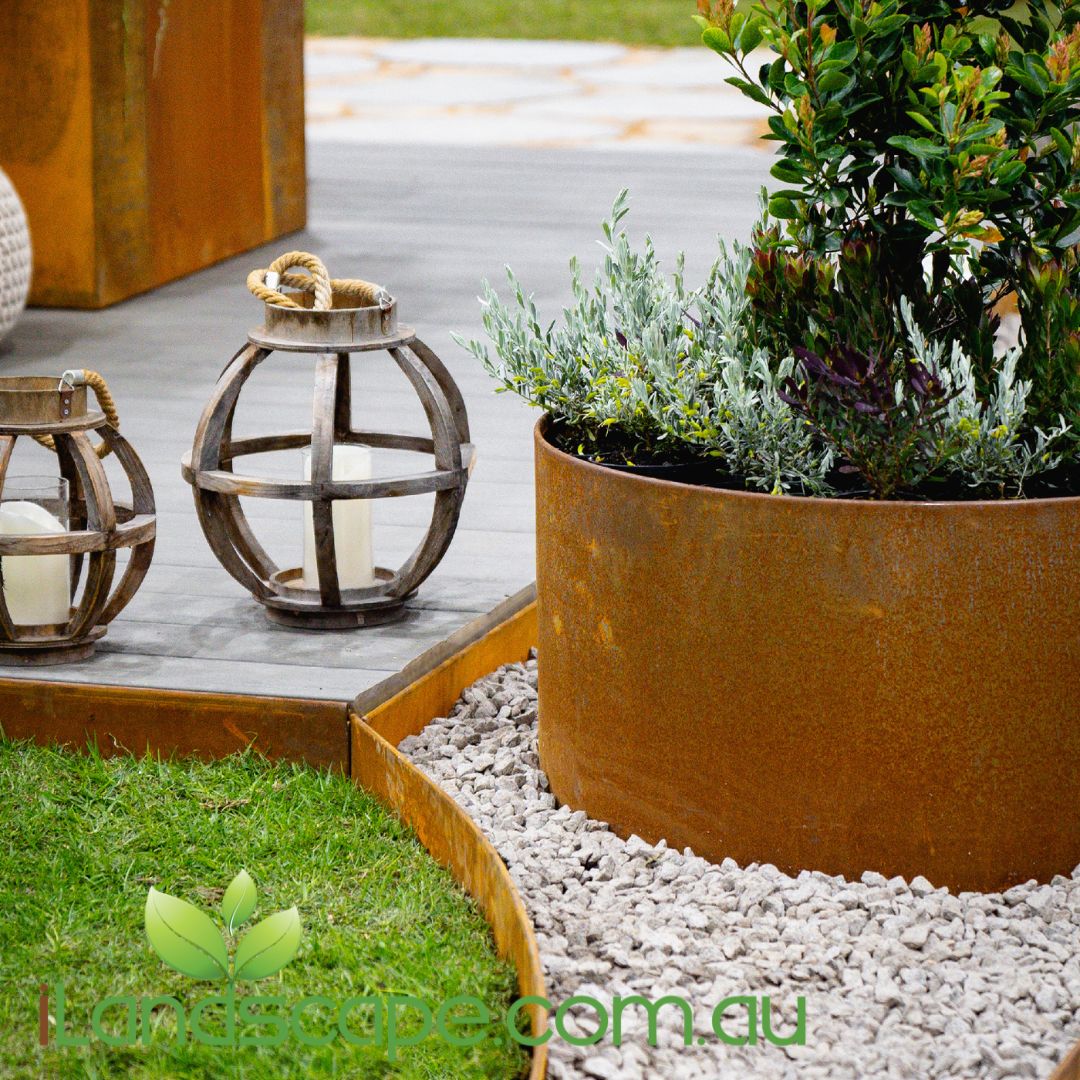
Redcor Steel Rings - 765mm Diameter
Steel Redcor rings Looking for something stylish in your next garden project check out the “rusted” REDCOR® weathering steel ring planters. Made from 2.0mm thick Australian bluescope steel these garden rings will set your next landscaping project apart from the rest Manufactured in Melbourne, Australia Steel rings are made to order, please allow approximately 10 days for ordering and delivery
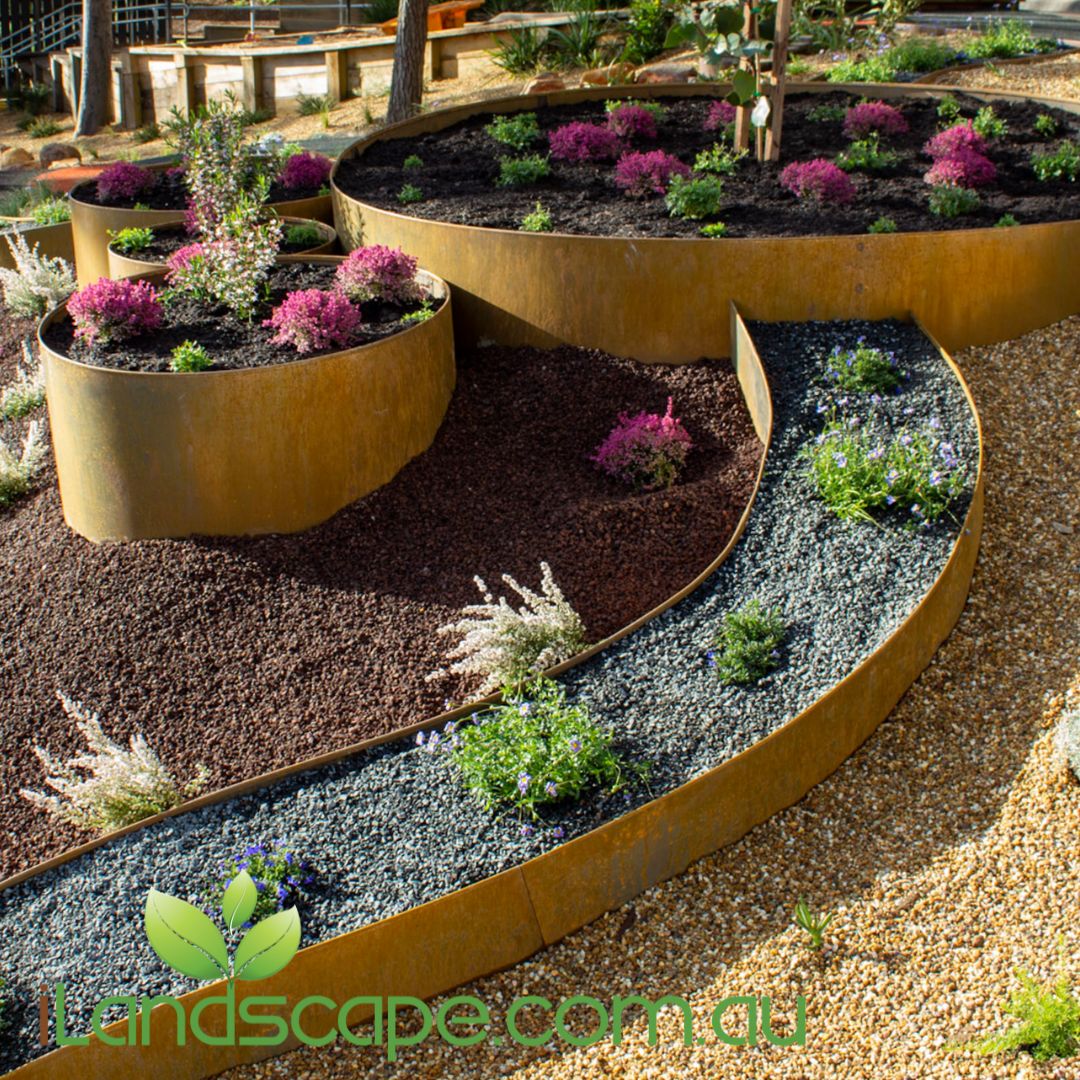
Redcor Steel Rings - 1150mm Diameter
Steel Redcor rings Looking for something stylish in your next garden project check out the “rusted” REDCOR® weathering steel ring planters. Made from 2.0mm thick Australian bluescope steel these garden rings will set your next landscaping project apart from the rest Manufactured in Melbourne, Australia Steel rings are made to order, please allow approximately 10 days for ordering and delivery
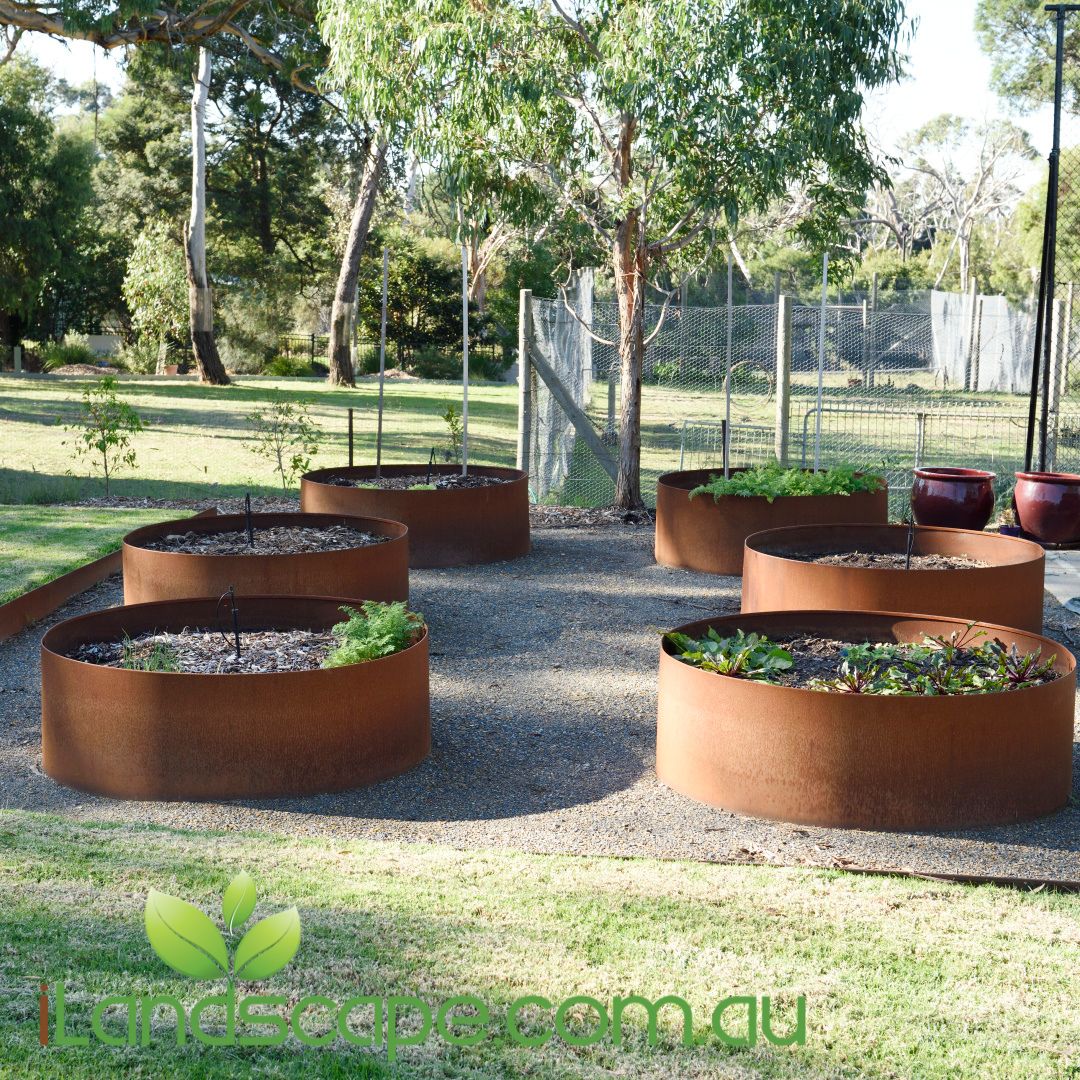
Redcor Steel Rings - 1530mm Diameter
Steel Redcor rings Looking for something stylish in your next garden project check out the “rusted” REDCOR® weathering steel ring planters. Made from 2.0mm thick Australian bluescope steel these garden rings will set your next landscaping project apart from the rest Manufactured in Melbourne, Australia Steel rings are made to order, please allow approximately 10 days for ordering and delivery
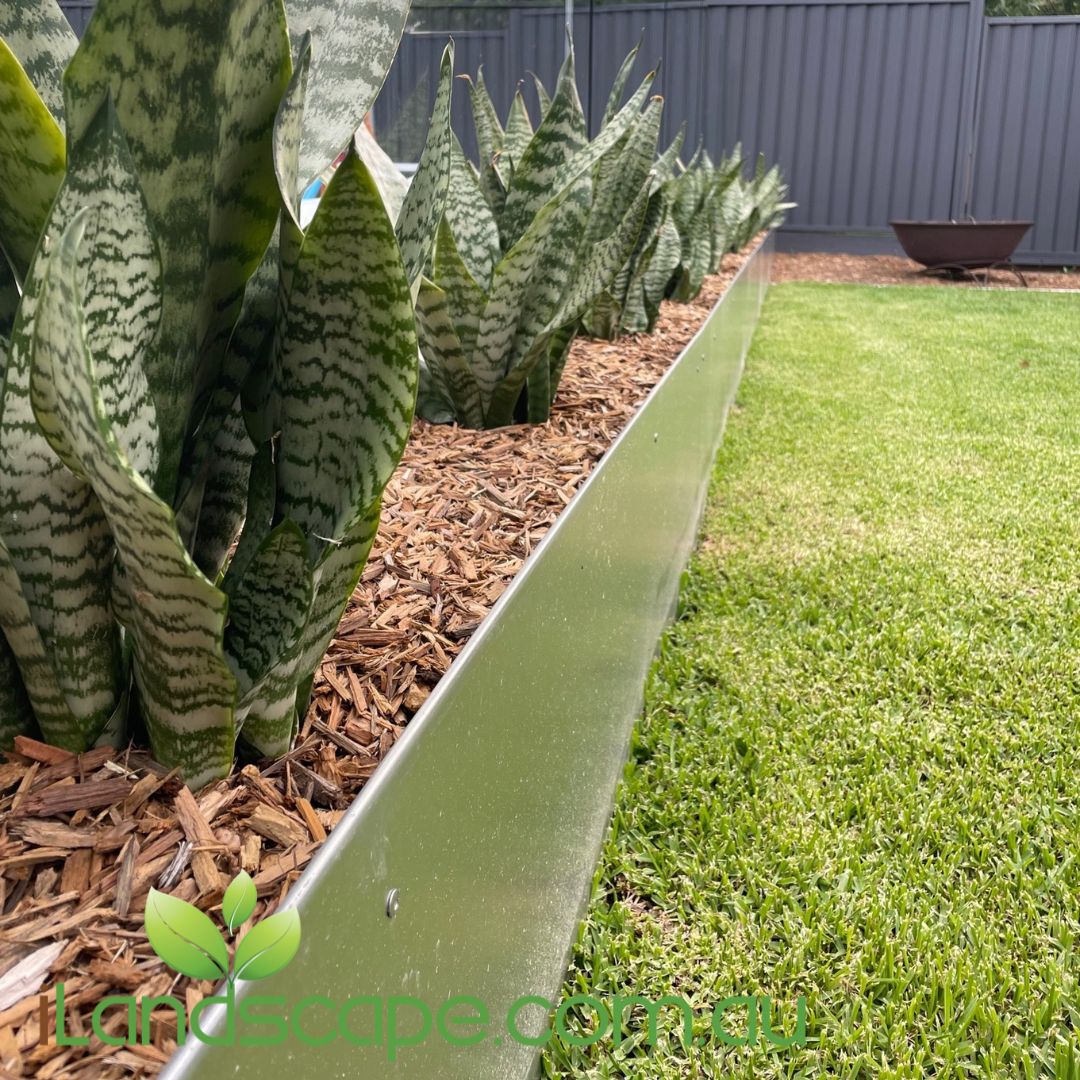
Galvanised Edging x 2.4m Lengths
AUSTRALIAN MADE GALVANISED STEEL EDGING – AN AFFORDABLE AND DURABLE EDGE. Our Australian made BlueScope®, hot dipped Galvanised steel edging has a structural guarantee of 10 years, ensuring your confidence when purchasing and installing FormBoss™ in your garden. Galvanised steel will appear shiny and spangled when first purchased, however after a year or so the shine will dull down to a matte grey, all though you will still be able to notice the spangled effect. Galvanised steel edging blends in very well, as grey is a neutral colour and doesn’t take the focus off the plants and lines of the garden, it creates flawlessly separated contrasts in your design. To get the most out of your Galvanised steel edging be sure to pick up some cold galvanised spray paint to cover the areas you screw or cut as doing this during the installation exposes the inner metal which needs to be covered to protect the longevity of the edging. If you notice some surface rust from being nicked with the mower or whipper snipper we recommend using a wire brush to brush down the area, ensure it’s dry, and then coating the areas generously with your cold galvanised paint. We supply edging for practically all garden applications, our retail gauges are perfect for your garden borders around your family home, however if you require something stronger for commercial pathways or concrete formwork, our industrial strength gauges will stand up to the most severe conditions and will last up to 40 years in the ground. Gauges Available & Heights Available: 1.6mm 100mm, 150mm, 185mm, Gauges Available & Heights Available: 2.0mm 230mm, 290mm, 390mm, 580mm Lengths are all 2.4m
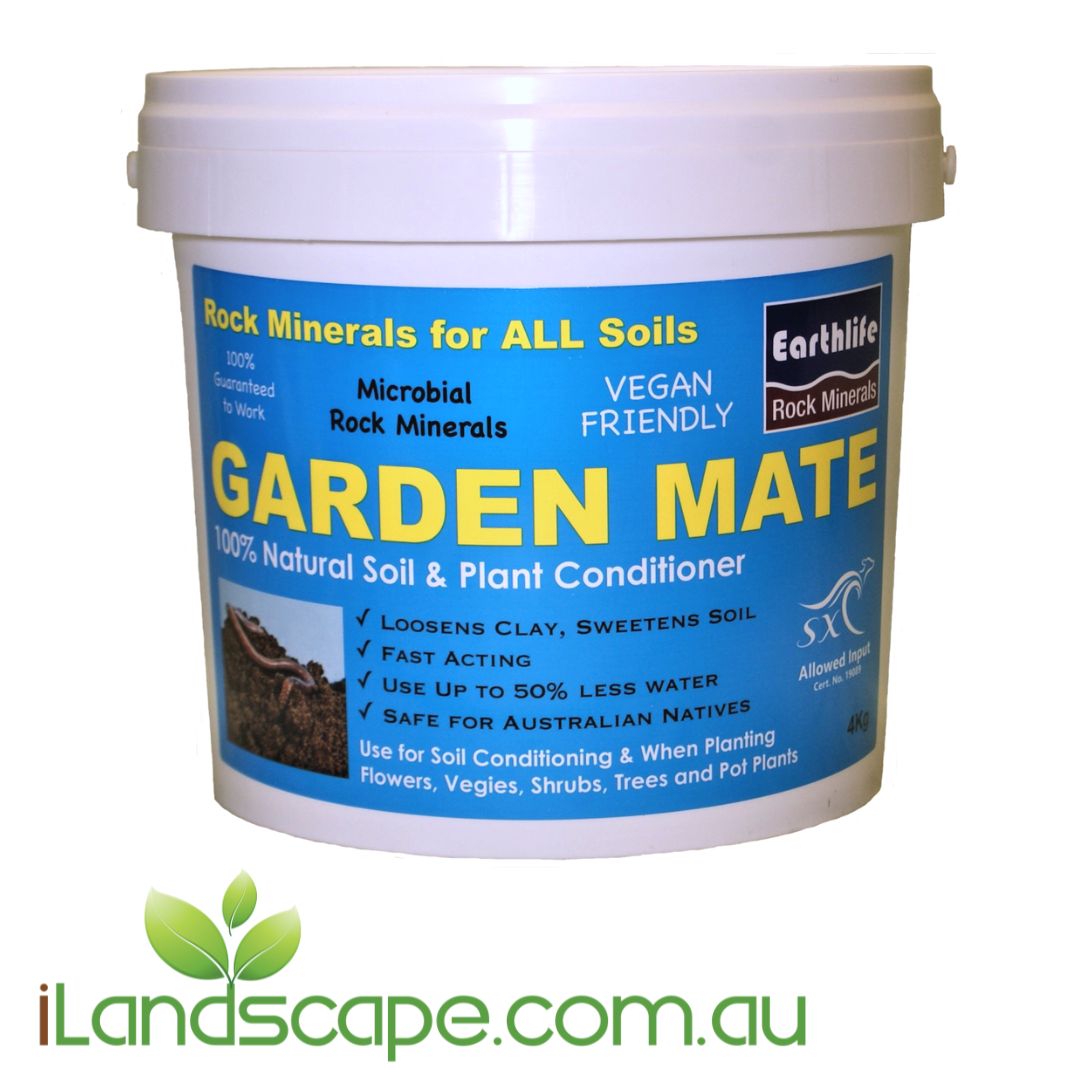
EarthLife Garden Mate
EarthLife Garden Mate Garden Mate is a fast acting clay breaker with no need to dig it in, just water. Most people notice improvements in 2-3 weeks after application. Why use Garden Mate? HAVE YOU EXPERIENCED: Watering your garden and the water sits on top? Bending the prongs on your digging fork? Breaking the blade on your transplanting trowel? Watering your garden and the plants still wilt? All of the above issues become a distant memory by using Garden Mate soil conditioner before, during and after preparation of your garden beds. What does it do? CLAY SOILS Garden Mate is a fast acting clay breaker with no need to dig it in, just water. Most people notice improvements in 2-3 weeks after proper application. If not then re-apply. Garden Mate breaks hydrophobic crust on all soil types, provides better moisture penetration, creates softer soil and improves drainage and nutrient availability. SANDY SOILS Binds sand particles together in sandy soils which reduces nutrient leaching and improves moisture availability.
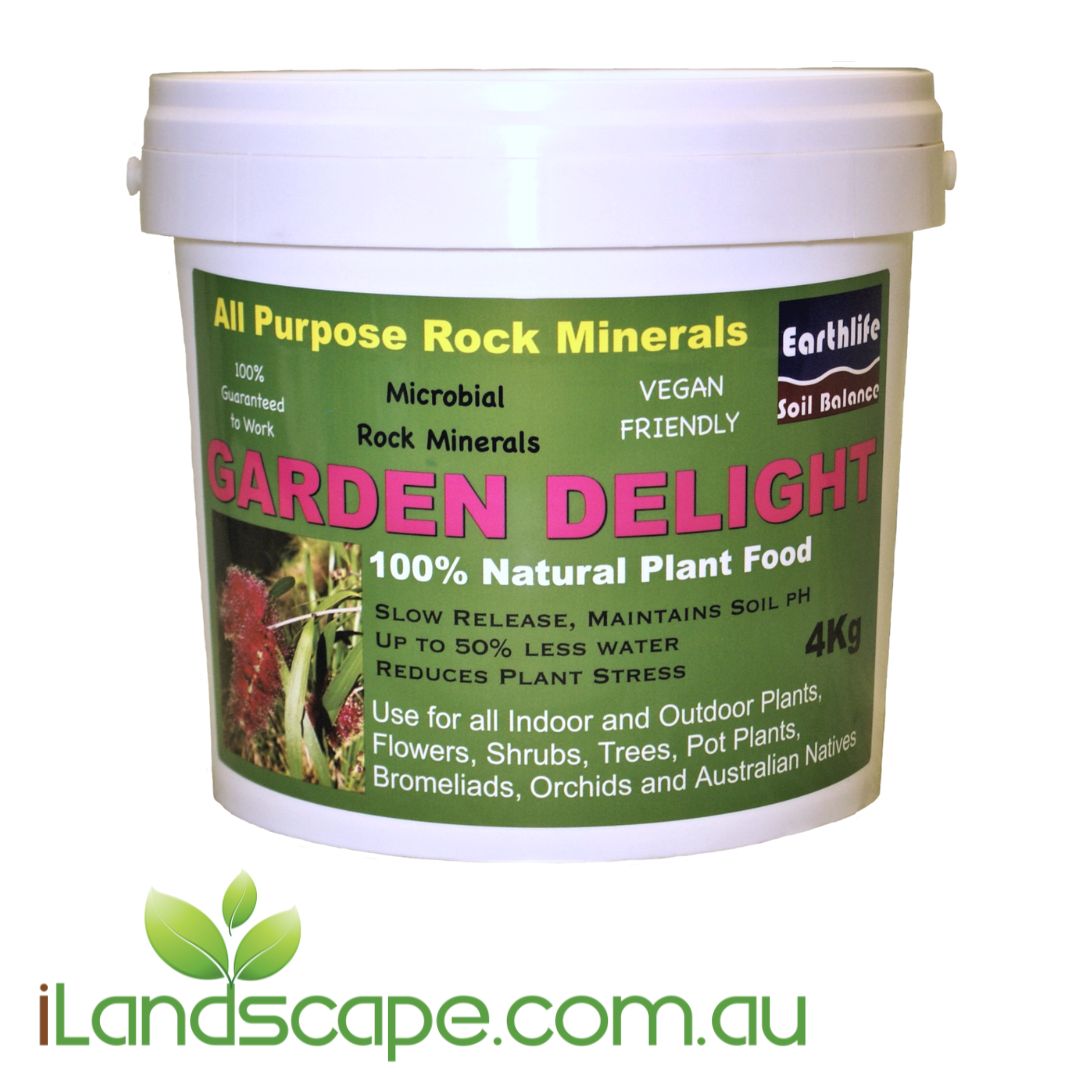
EarthLife Garden Delight
EarthLIfe Garden DelightA 100% natural composed plant food containing 60 mineral elements and humates including natural rock phosphate, plant available silica, organic material and over 30 beneficial microbes and fungi species.Does not contain animal waste eg. manures. A balanced diet for your plants, minimising the need for synthetic supplements.Garden Delight is very environmentally friendly, and is safe for use in playgrounds, parks and your home gardens and is also Vegan friendly.What does it do? Promotes healthier plants more able to withstand adverse conditions. Encourages earthworm activity. Why use Garden Delight?Garden Delight is a superior fertiliser to other forms of organic material (eg. feedlot or poultry manure). It contains a balanced range of nutrients to promotewater retention, restore soil fertility and grow healthier plants.Soil is comprised of a multitude of minerals, microorganisms, organic material and humus. The fact that each component of the soil is equally as important asthe next is often overlooked. Earth Life Pty Ltd has developed Garden Delight with sufficient quantities of major and minor elements for strong, healthy plantgrowth.
Whenever we are potting Plants into Pots in our Garden Centre we use the Rocky Point & Searles Premium Potting Mix
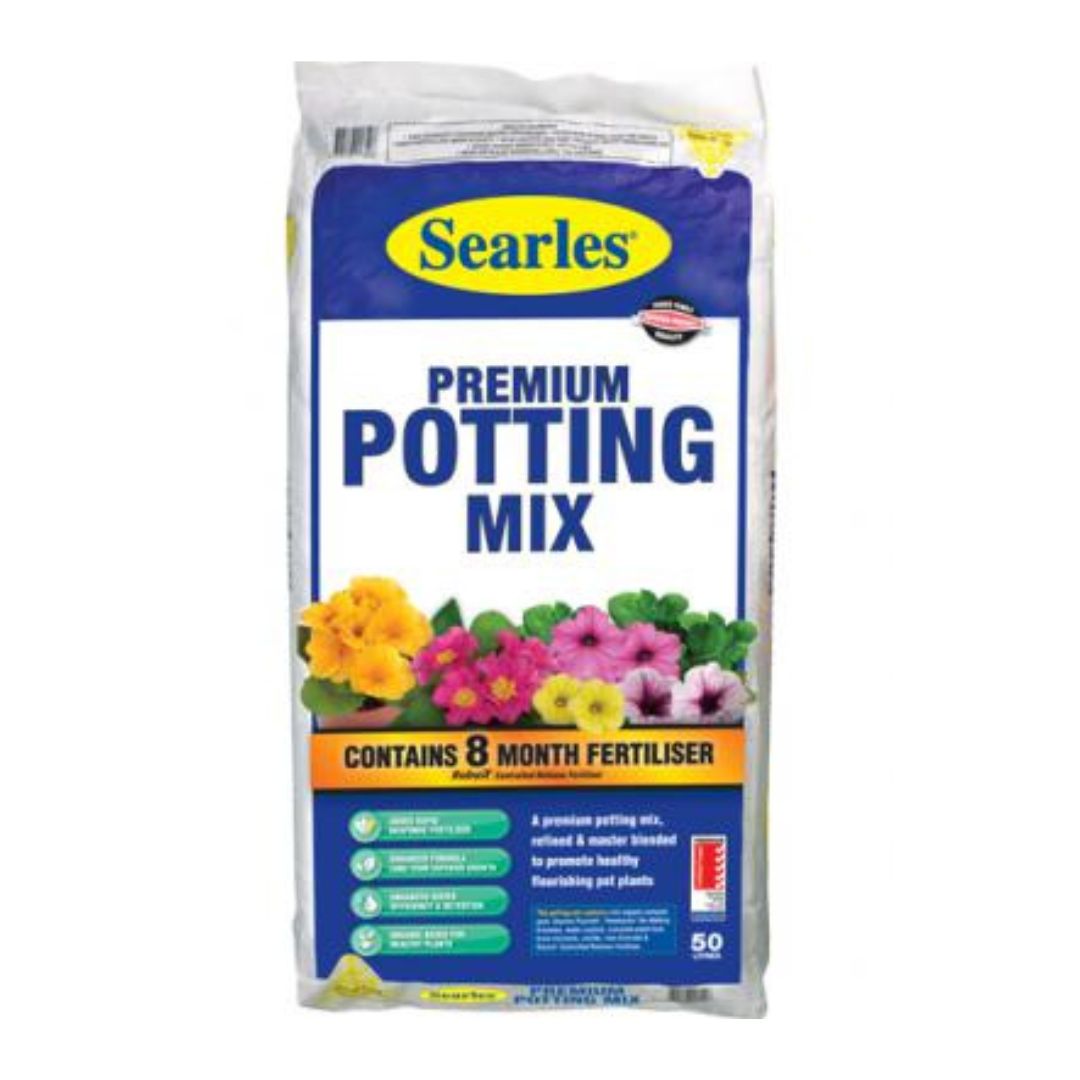
Searles Premium Potting Mix
Searles Premium Potting Mix is a high-quality potting mix containing a refined blend of selected high-quality ingredients. Also contained in this mixture is a specific amount of real organic compost and humus, which acts as a storehouse of nutrients, having the ability to store nutrients on colloid surfaces, protected from leaching while still being available to the plant when the plant requires more.This premium potting mix has excellent water retention properties while also allowing ideal drainage, providing the optimal growing conditions for your loved plants. Designed for excellent physical structure, maintaining a high capacity of water retention whilst also providing outstanding aeration, so important for plants grown in smaller containers and for the development of healthy feeder roots.- BOOSTED WITH 8 MONTH ROBUST® FERTILISER FOR SUSTAINED HEALTHY GROWTH & FLOWERING- Added rapid response fertiliser which delivers essential nutrients immediately after planting.- Excellent mutli-purpose premium grade potting mix (indoor, outdoor and semi-shade).- Contains Penetraide® Re-Wetting Granules and Water Crystals.- Contains Robust® Controlled Release Fertiliser.- Contains Zeolite plus added Trace Elements and Minerals.- Contains Peat, Coir plus Premium Organic Compost.- Also ideal for self watering pots
We Deliver locally all over the Sunshine Coast for $65.00 per load in our plant truck
Real people, real feelings and experienced horticulturist that can help you every step of the way
Buy with confidence from people who love to grow plants using only the best products
We love coming here. We always get what we want. And always attended to by amazing helpful staff. Best plants around. Never disappoints.
We visited iLandscapes in Caloundra while working on our own garden renovations and were so impressed! The lady who helped us was extremely knowledgeable, friendly, and genuinely interested in what we were trying to create. She gave us great advice and helped us choose the perfect plants for our space. Such a great local business with top-notch service, we’ll definitely be back!
Easy to work with and look good when installed.
Great service and price. Very happy come across them
First visited a couple of months ago. Very impressed with the selection and quality of plants. Also the staff were very friendly and helpful. Will definitely be back.
I really like them now that the edging and the stakes are fully predrilled for attachment. Easy to work with and look good after a few days in the weather. Take care when bolting them on - they will sometimes swing around hard as the tech screws tighten - nearly lost a thumb! (But that might be my poor skills!)
Fantastic service, and a great selection that is well suited to the area
A small nursery with a lovely selection. A helpful staff member actually took the time to talk to us about what kind of plant would work best and helped by placing them in different pots to get the right look. Very happy with our purchases, the plants are healthy and pots look great. Definitely will be back
Picked up 2 beautiful pots today at half price and all the plants are really reasonably priced!
Just wanted to show my appreciation towards Jason and his wonderful team for helping us start a native garden and for helping us choose some wonderful colours and styles that have really transformed our yard. Thank you!
Fantastic communication
Quality plant as described
Quick delivery
This is only a small nursery with some really nice plants and trees.
The service here is outstanding. Highly friendly staff who really know their horticultural knowledge. Assisted us with picking the right plants, fertiliser, and delivery. Will be returning for more.
Easy parking next door and always great service
Jason and team are worth 10 stars! So helpful, so friendly! While I am a builder I have no knowledge of plants at all, left that to my brother and nephew who no longer can help. Jason came up with a plan for me, put them in today and the project is now finished off perfectly. Thanks again Jason! Will definitely be coming in again and will be recommending you to everyone. Thanks!
Great variety of plants, pots, etc.
ILandscape is a friendly, knowledgeable nursery with helpful staff, offering a great selection of healthy plants and reasonable prices. Customers appreciate the personalized service, creative displays, and wide variety of plants suited for the area. The nurser... ILandscape is a friendly, knowledgeable nursery with helpful staff, offering a great selection of healthy plants and reasonable prices. Customers appreciate the personalized service, creative displays, and wide variety of plants suited for the area. The nursery provides an enjoyable and trustworthy shopping experience.
Read moreBe the first to know about new collections and exclusive offers.
I really like them now that the edging and the stakes are fully predrilled for attachment. Easy to work with and look good after a few days in the weather. Take care when bolting them on - they will sometimes swing around hard as the tech screws tighten - nearly lost a thumb! (But that might be my poor skills!)
Fantastic communication
Quality plant as described
Quick delivery
We love coming here. We always get what we want. And always attended to by amazing helpful staff. Best plants around. Never disappoints.
We visited iLandscapes in Caloundra while working on our own garden renovations and were so impressed! The lady who helped us was extremely knowledgeable, friendly, and genuinely interested in what we were trying to create. She gave us great advice and helped us choose the perfect plants for our space. Such a great local business with top-notch service, we’ll definitely be back!
Easy to work with and look good when installed.
Great service and price. Very happy come across them
First visited a couple of months ago. Very impressed with the selection and quality of plants. Also the staff were very friendly and helpful. Will definitely be back.